

Damion Smy
Nissan Juke EV will use Leaf platform, due in 2026 - report
13 Hours Ago
We put the top-spec Mazda CX-5 to the test to see if it's a $15,000 better car than the top-spec Haval H6.

News Editor
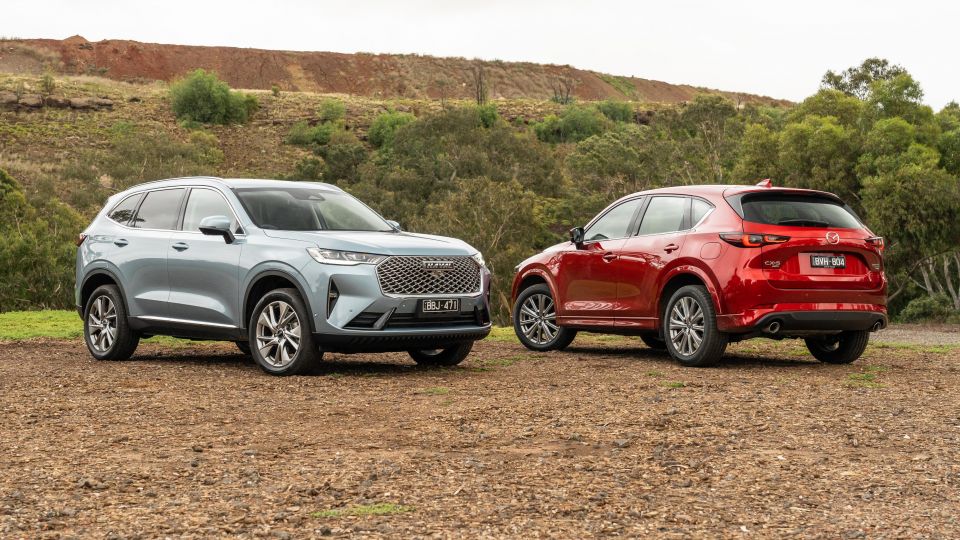

News Editor
Before you are two range-topping mid-sized SUVs with turbo-petrol power, but between them is a sizeable gulf in price.
The CX-5 is Mazda’s best seller in Australia, and the nameplate first appeared here in 2012. It’s so popular, it’s outsold by only one other mid-sized SUV: the Toyota RAV4.
The Haval H6, in contrast, is a relative upstart. The forgettable first-generation model arrived here in 2016, but it’s the redesigned model that appeared last year which has helped jumpstart the Haval brand’s sales here.
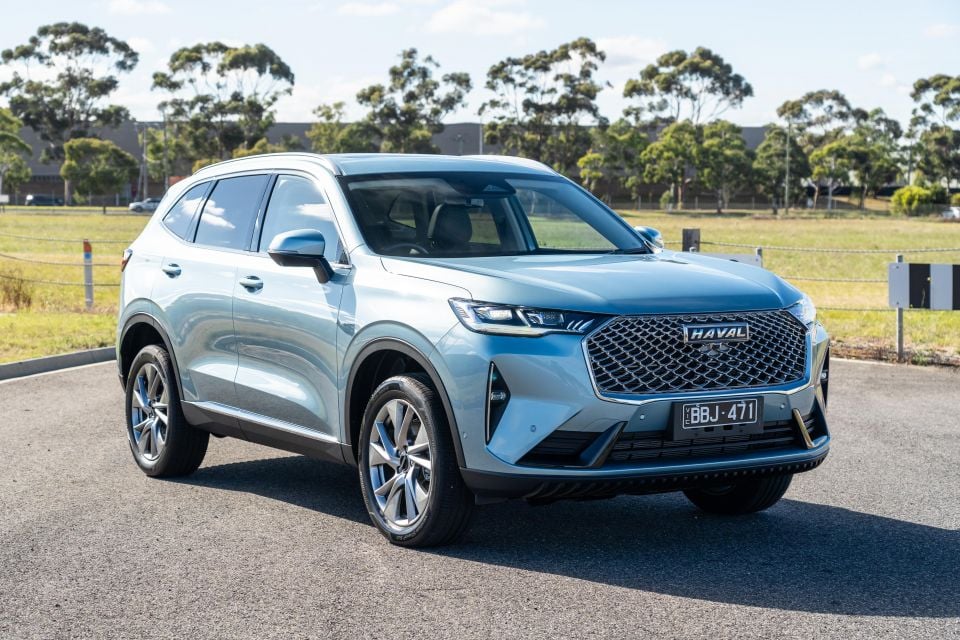
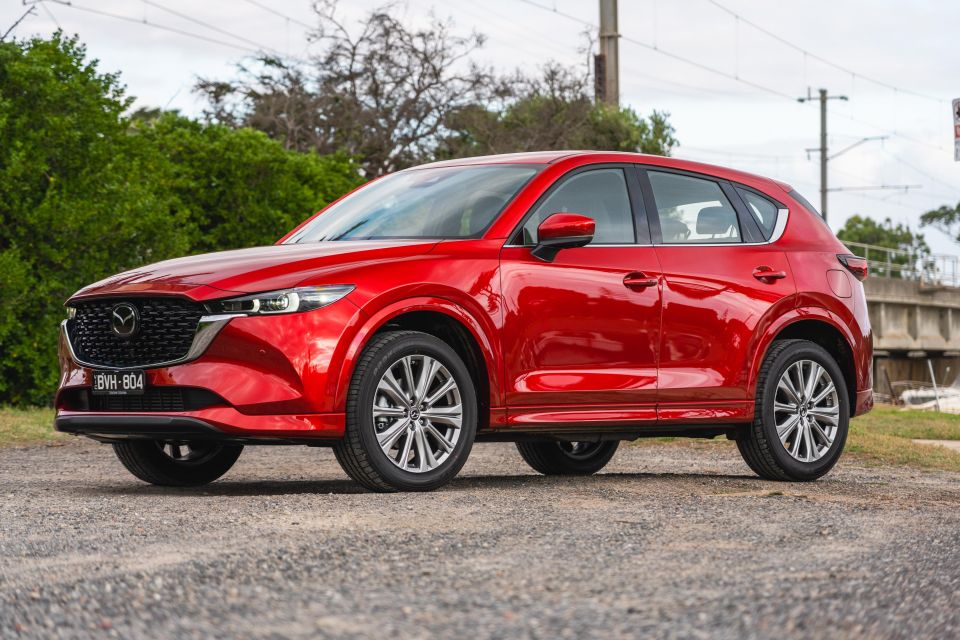
While GWM Haval Australia has increased prices of the H6 by up to $4000 since the launch of the current model, it still offers – much like the MG HS, also from China – a tantalising value proposition.
Since the current H6’s launch, Mazda has given the CX-5 a mild refresh for 2022. We’ve therefore put range-topping petrol-powered versions of the Mazda CX-5 and Haval H6 to the test to see if the updated version of the more familiar, established nameplate is worth a premium of over $15,000.
The other question, of course, is to work out if this lesser-known upstart model is actually any good.
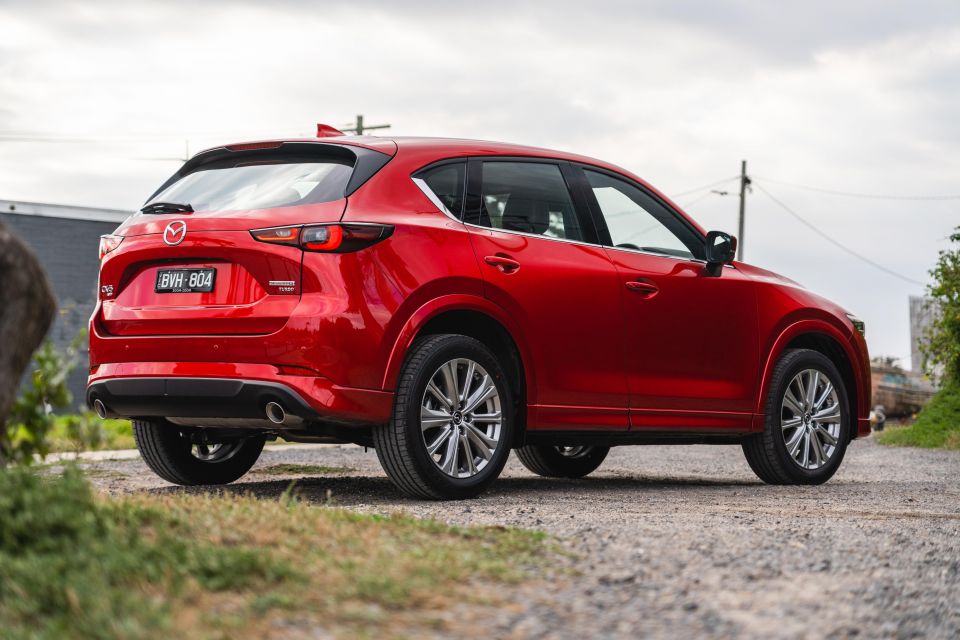
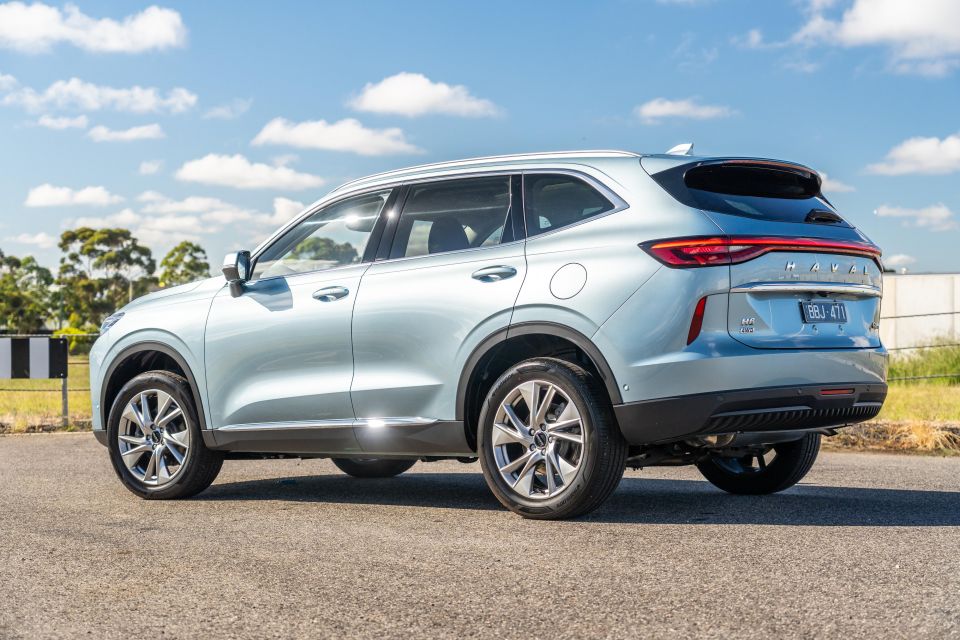
Both the CX-5 and H6 tested here are the second most-expensive models in their respective line-ups.
The CX-5 Akera 2.5T is priced at $53,180 before on-road costs, or $58,982 drive-away based on a Sydney postcode. Its twin-turbo diesel counterpart is the priciest CX-5, costing $500 more.
Our tester featured $695 Soul Red Crystal paint, one of only a handful of extra-cost finishes and wonderfully lustrous. There’s a range of mica finishes plus one metallic option that are available for no extra cost.
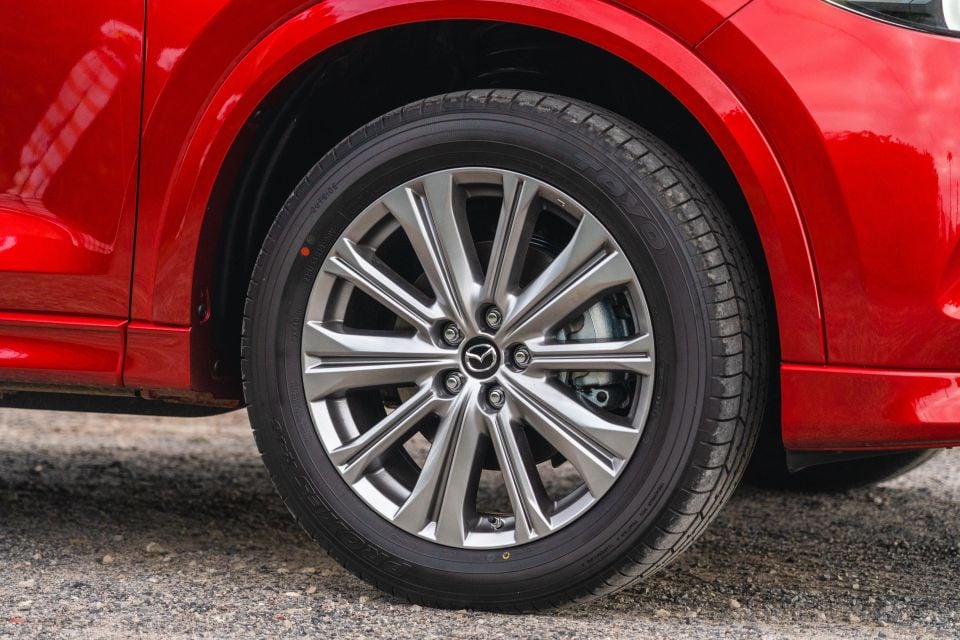
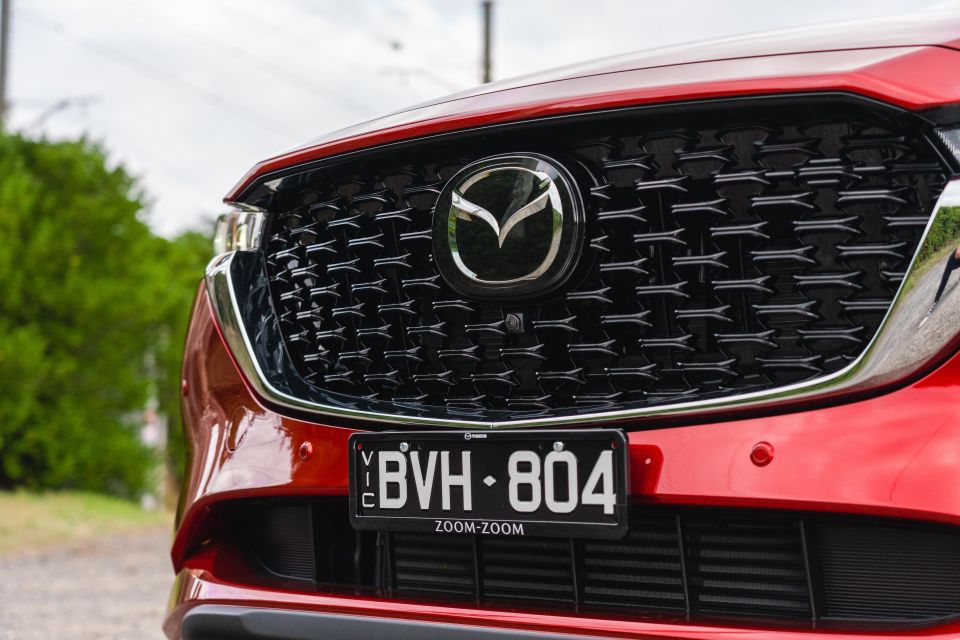
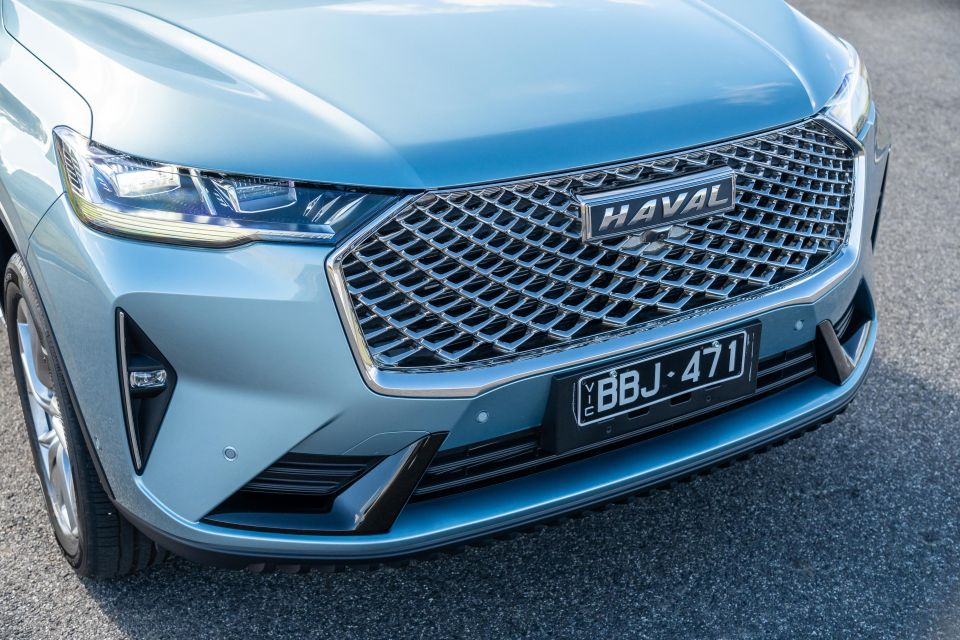

The H6 Ultra AWD was top of the H6 pecking order until the launch of the special edition Vanta black pack and the new hybrid model. It’s priced at $42,990 drive-away, with our tester’s Energy Green paint an extra $495.
Don’t let the name fool you: it’s more of a pale blue, and it’s a distinctive shade.
The cheapest CX-5, the naturally-aspirated 2.0-litre Maxx manual costs $32,190 before on-roads, while the cheapest H6, the Premium, is $33,990 drive-away.
Pricing
Price based on a Sydney postcode.
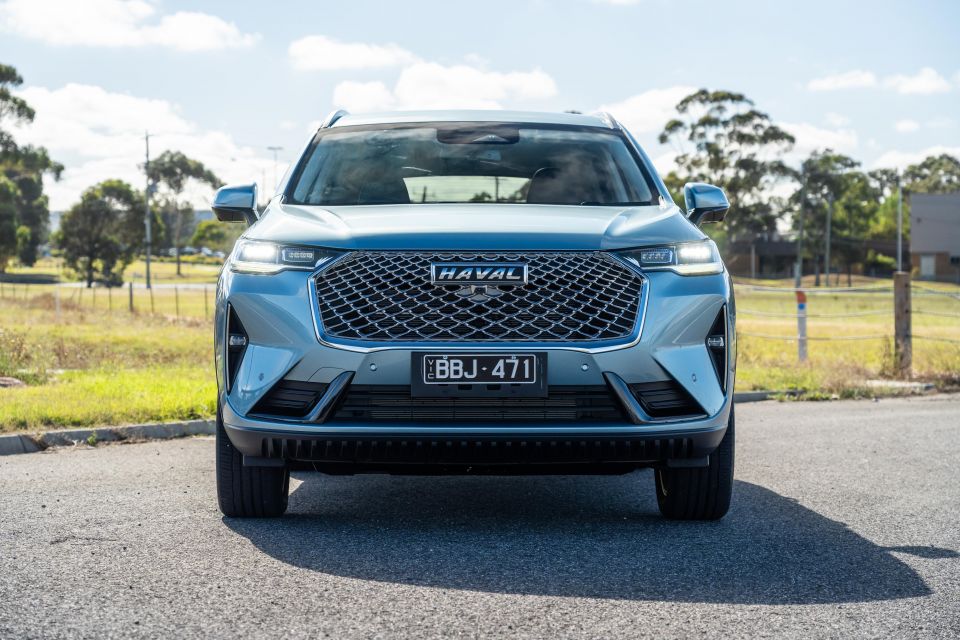
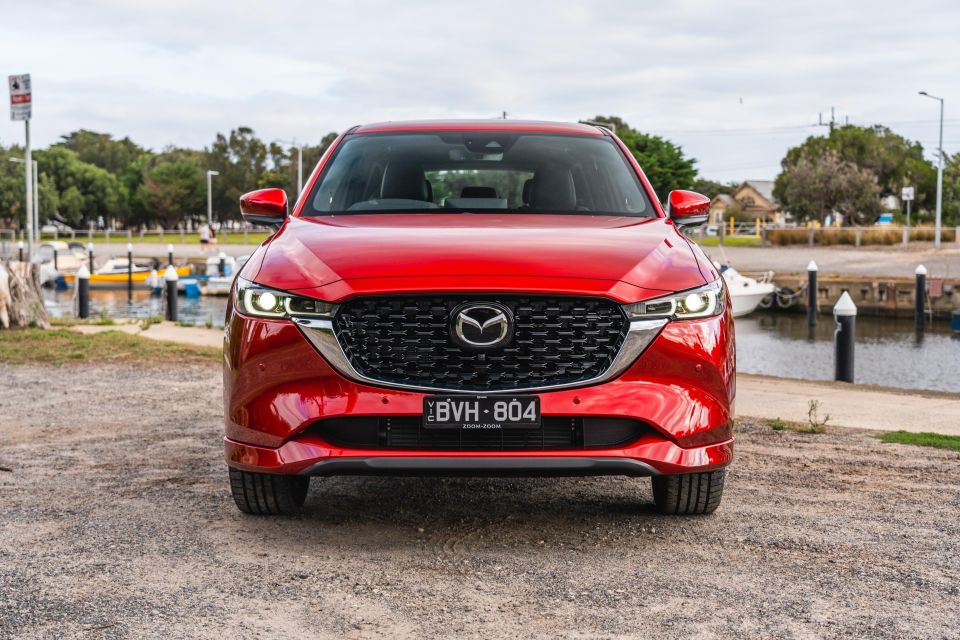
Both models receive:
| Mazda CX-5 Akera | Haval H6 Ultra | |
|---|---|---|
| Seat trim | Nappa leather | Comfort-Tek artificial leather |
| Driver’s seat | Heated, ventilated, 10-way power adjustable | Heated, ventilated, 8-way power adjustable |
| Passenger’s seat | Heated, ventilated, 6-way power adjustable | Heated, ventilated, 4-way power adjustable |
| Heated rear seats | Yes | No |
| Air-conditioning | Dual-zone climate control | Dual-zone climate control |
| Rear-view mirror | Frameless, auto-dimming | Auto-dimming |
| Heated steering wheel | Yes | Yes |
| Keyless entry and start | Yes | Yes |
| Parking sensors | Front and rear | Front and rear |
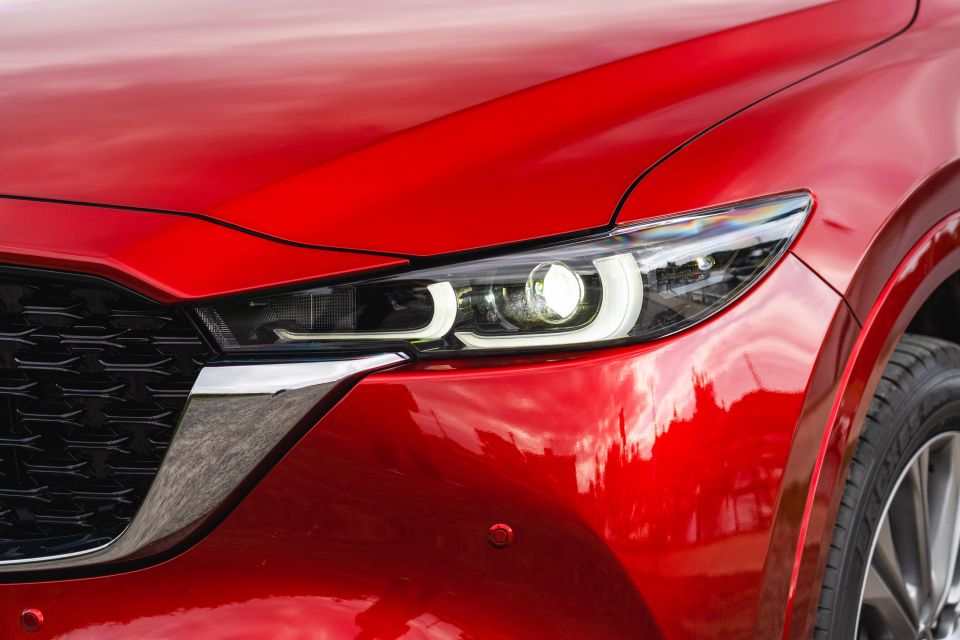
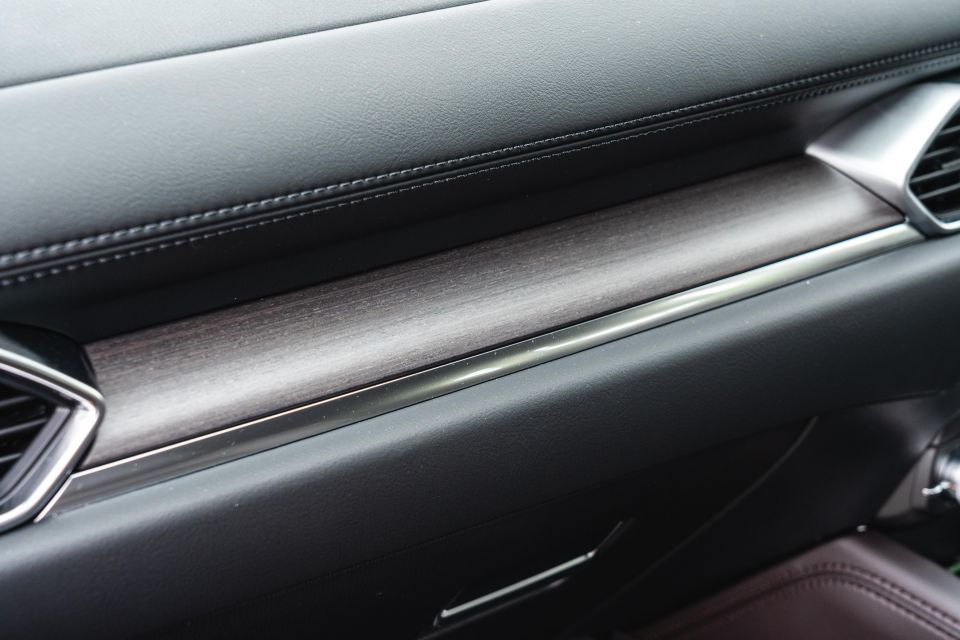

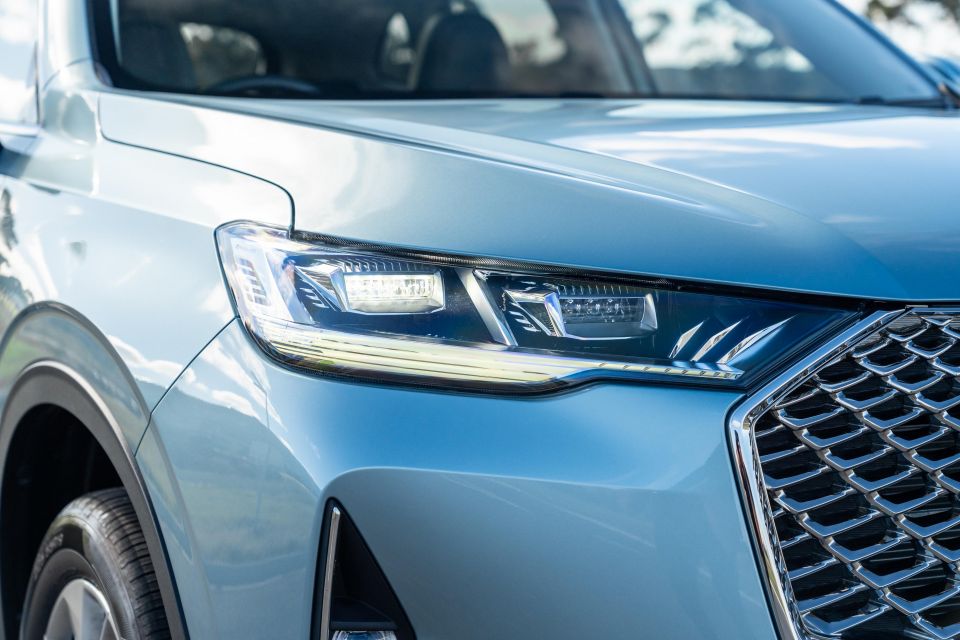
Unique to the Mazda are:
Unique to the Haval are:
MORE: 2022 Mazda CX-5 price and specs MORE: 2022 Haval H6 price and specs
| Mazda CX-5 Akera | Haval H6 Ultra | |
|---|---|---|
| Head-up display | Yes | Yes |
| Infotainment screen | 10.25-inch | 12.3-inch touchscreen |
| Satellite navigation | Yes | No |
| Apple CarPlay & Android Auto | Yes | Yes |
| Sound system | 10-speaker Bose | 8-speaker |
| Wireless phone charger | Yes | Yes |
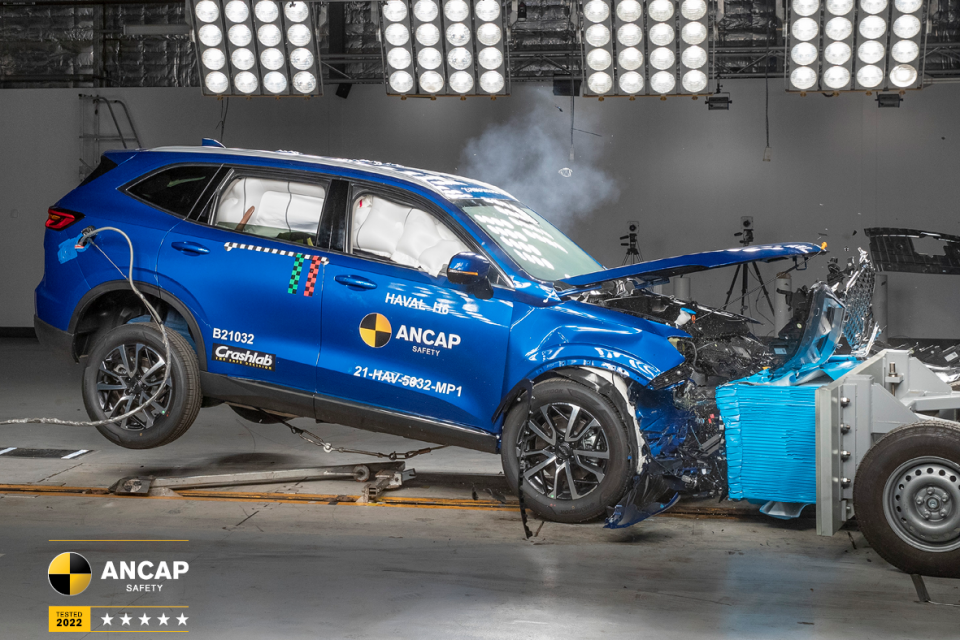

Both of these vehicles scored five stars in ANCAP safety testing, with the following results:
Mazda CX-5
Haval H6
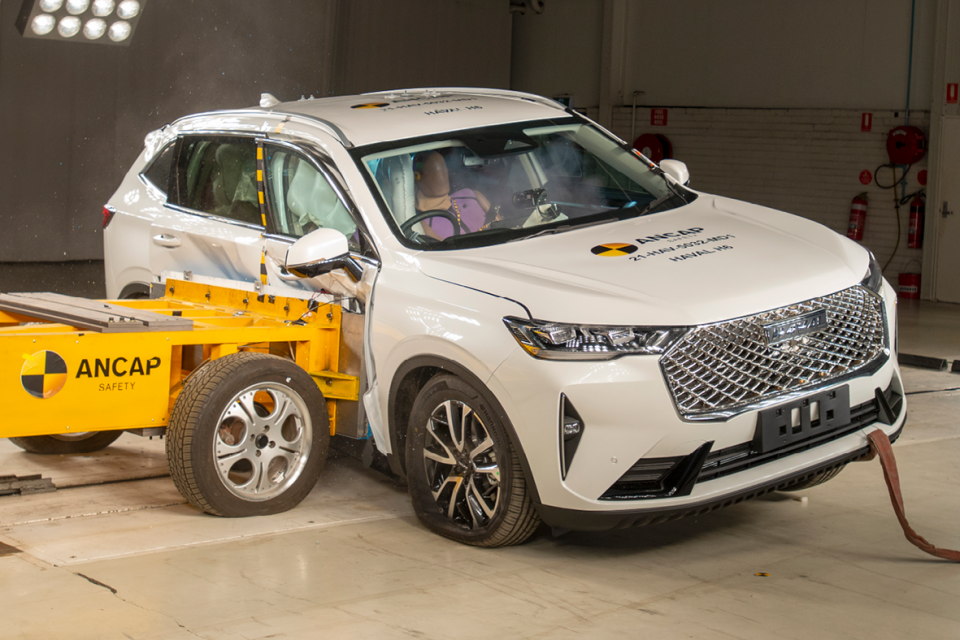
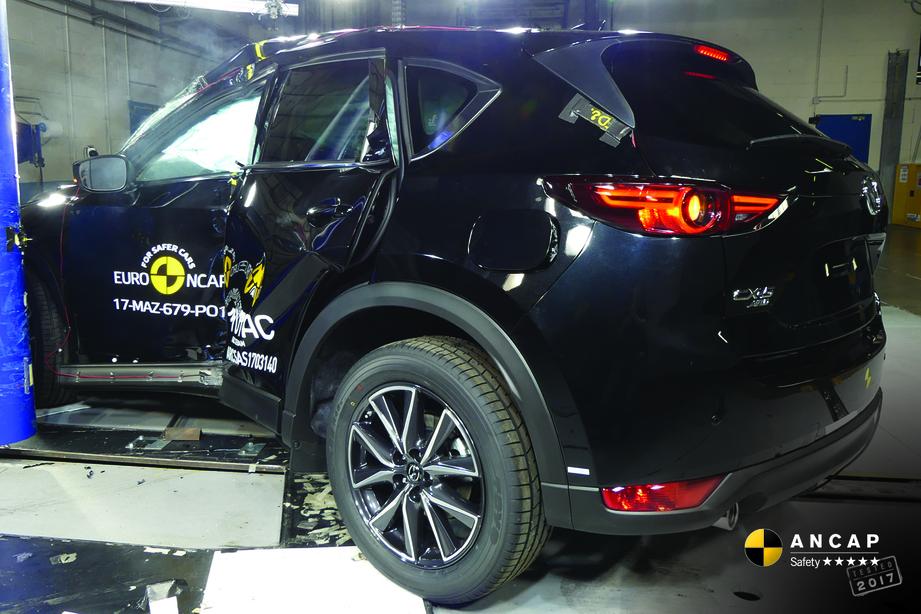
Both vehicles come standard with the following safety equipment:
The H6 additionally features a lane-centring function, a safe exit warning system, a centre airbag, and cyclist detection and junction assist for the AEB system.
| Mazda CX-5 Akera | Haval H6 Ultra | |
|---|---|---|
| Airbags | Front, front-side, curtain | Front, centre, front-side, curtain |
| Child seats | 2 x ISOFIX, 3 x top tether | 2 x ISOFIX, 3 x top tether |
| Autonomous emergency braking | Car and pedestrian | Car, pedestrian and cyclist; junction assist |
| Lane-keep assist | Corrective steering, alerts | Corrective steering, alerts |
| Blind-spot monitoring | Yes | Yes |
| Rear cross-traffic alert | Yes | Yes |
| Cruise control type | Adaptive | Adaptive |
| Traffic sign recognition | Yes | Yes |
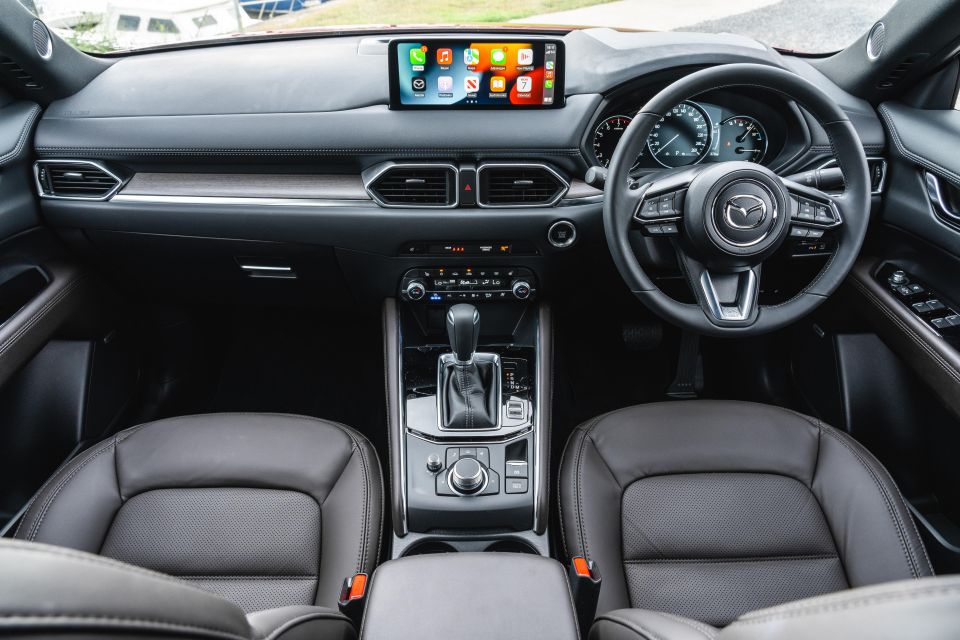
Mazda CX-5
The Mazda doesn’t have the visual drama of the Haval’s interior, but its presentation is more polished.
The Akera’s real wood inserts, for example, are a subtle, classy touch. Most of the dashboard is covered in soft-touch plastics, while the sides of the centre console are finished in leatherette trim and the centre console bin has a particularly softly-padded lid.
There are knurled dials and elegant stitching details, and the rotary dial has a well-damped, European look and feel to it.
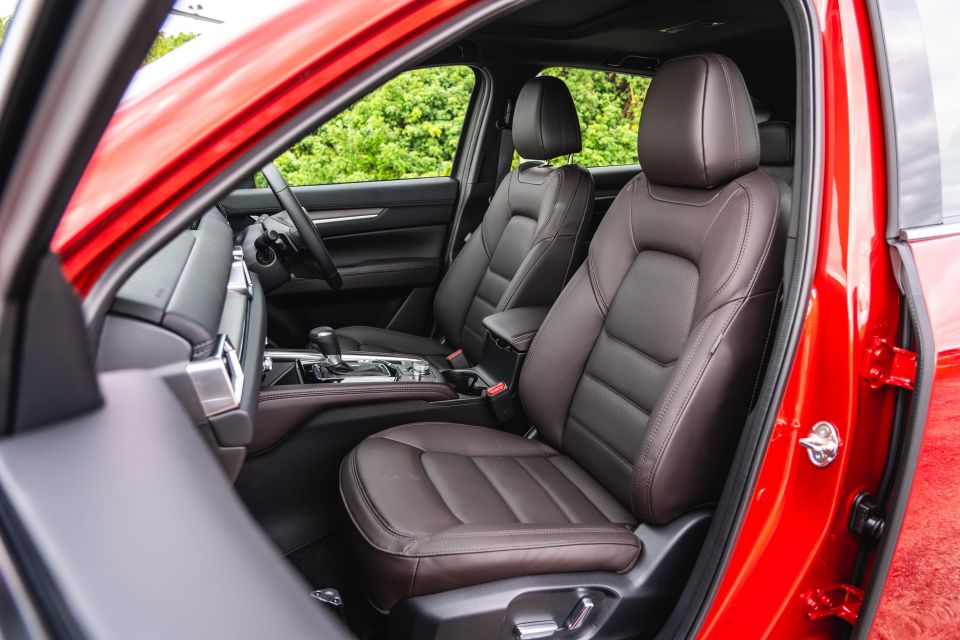

The seats and door trims are finished in brown leather, which may seem like an odd contrast with the black of the rest of the cabin but is surprisingly subtle and pleasant in execution. This isn’t like wearing a black belt with brown shoes. The Nappa leather also has a nice smell to it.
The instruments are analogue, which depending on your point of view makes them either conserative and old-fashioned or timeless. We reckon they won’t date as quickly as the Haval’s digital instruments – remember, digital instrument clusters rarely offer over-the-air updates.
The head-up display is clear and easy to read, though it can’t be used to display turn-by-turn navigation directions from Apple Maps or Google Maps.
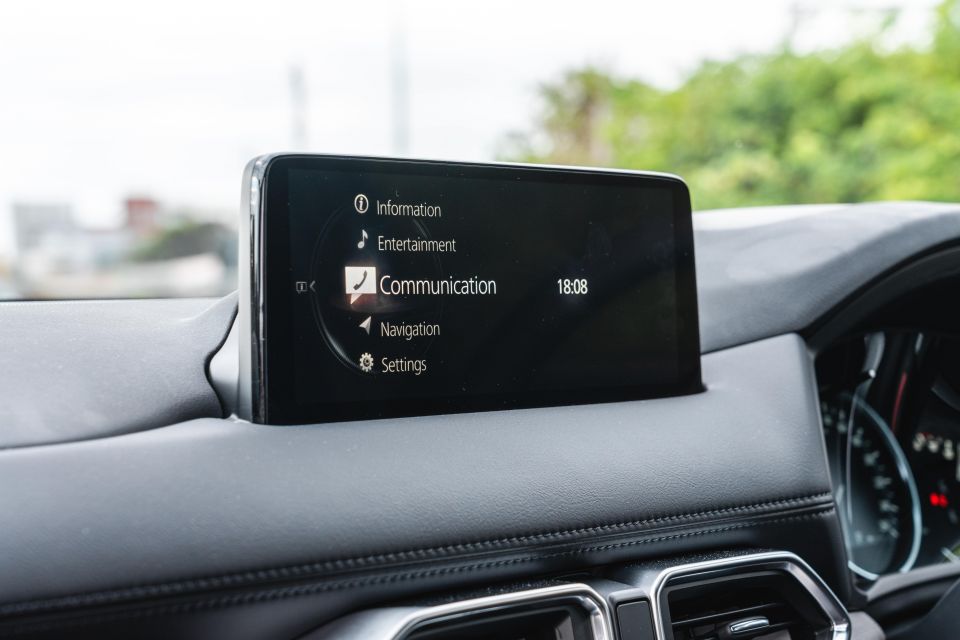
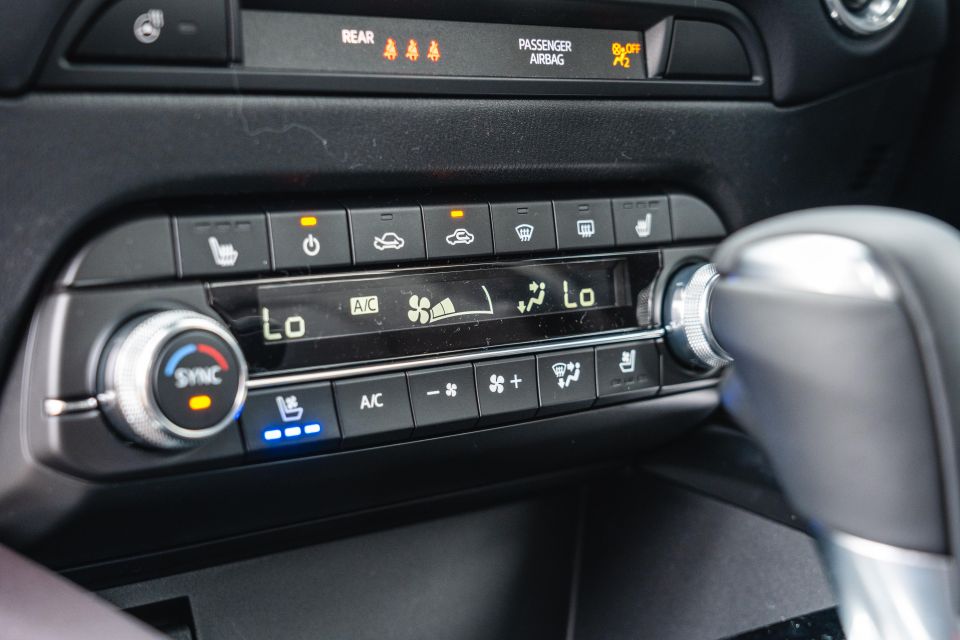
The Mazda and the Haval confound users in different ways. The H6 relies too heavily on the touchscreen, while the Mazda lacks one entirely.
Its 10.25-inch display screen is well-sized, features an attractive user interface and quick response times, and is easily navigated – for the most part – using the tactile rotary dial. But using smartphone mirroring with a rotary dial is maddening, turning simple actions like zooming out on Google Maps into exercises in frustration.
If we’re nitpicking, the centre stack is showing its age a little bit, the plastic paddle shifters don’t look or feel quite as nice as the metal-look Haval numbers, and the plastic insert on the bottom steering wheel spoke makes it impossible to stick your hand in there.
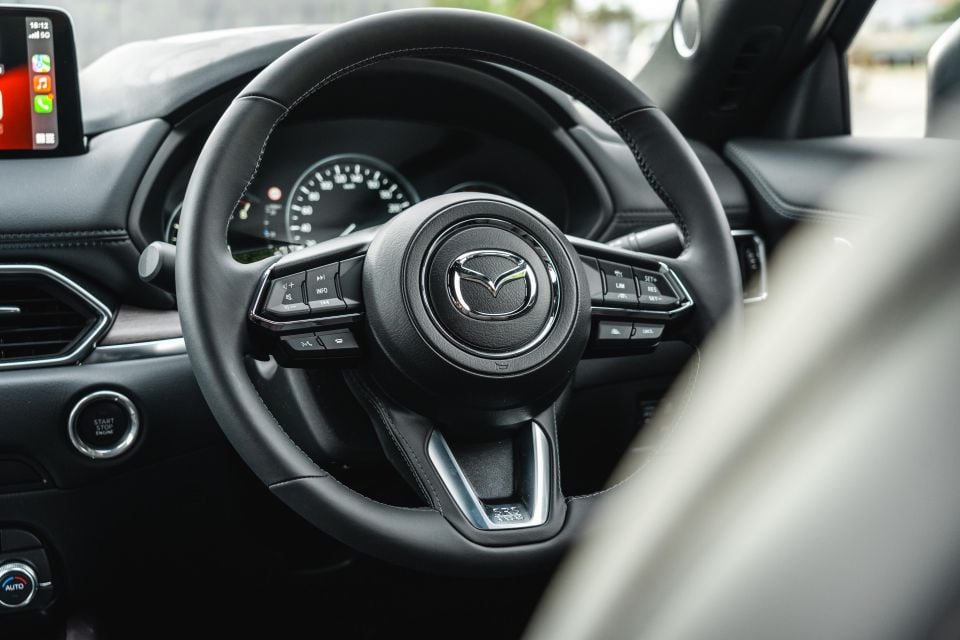
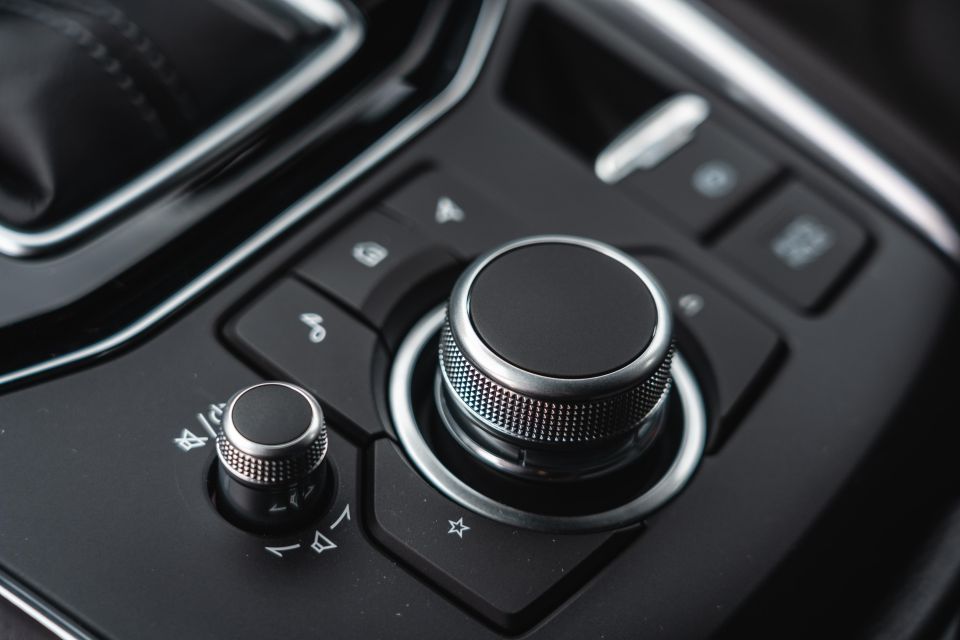
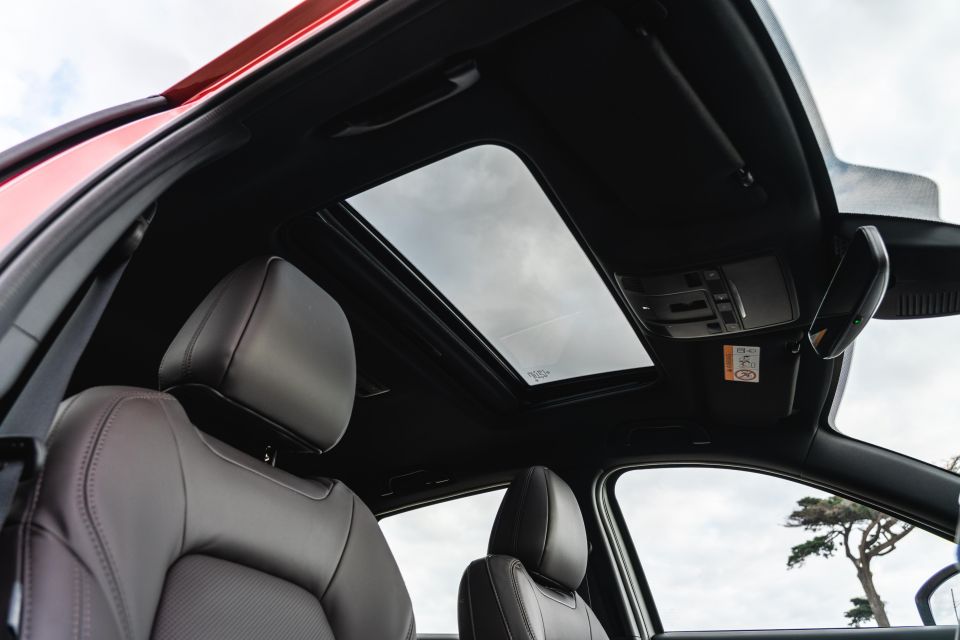
There’s also piano black trim on the centre console like the Haval and, sadly, too many cars today.
Mazda seems to want to minimise distractions, angling the wireless phone charger away from the driver and tucking the USB-A outlets inside the centre console bin. The 12V outlet, however, is located at the base of the centre stack.
The CX-5’s interior gets more right than wrong. Its Bose sound system, for example, surpasses the Haval’s unbranded one, while its ventilated seats produce powerful gusts of air compared to the H6’s tepid breezes. Its seats are also quite comfortable, if not quite as cushy as the Haval’s.
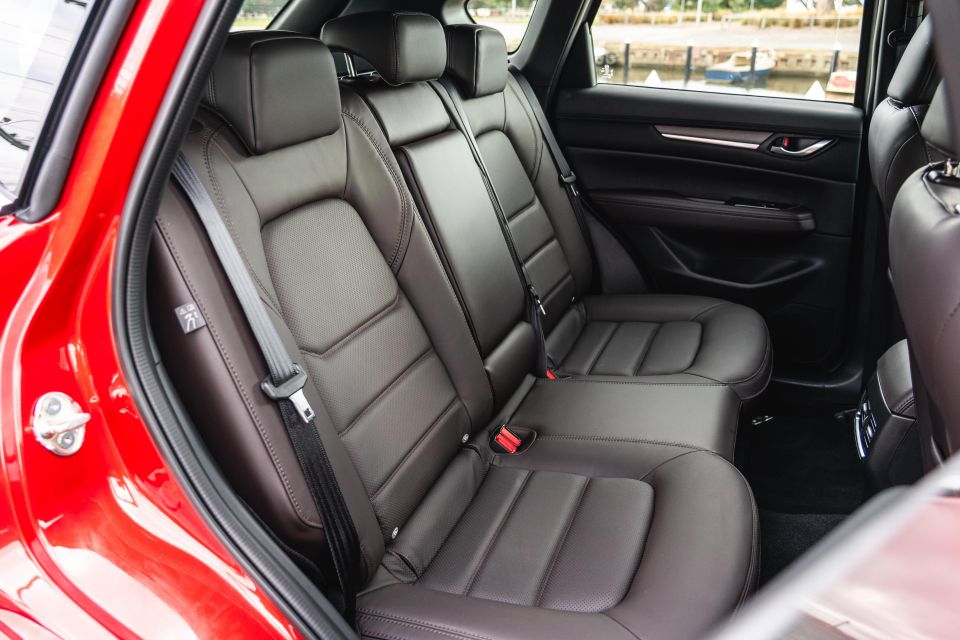
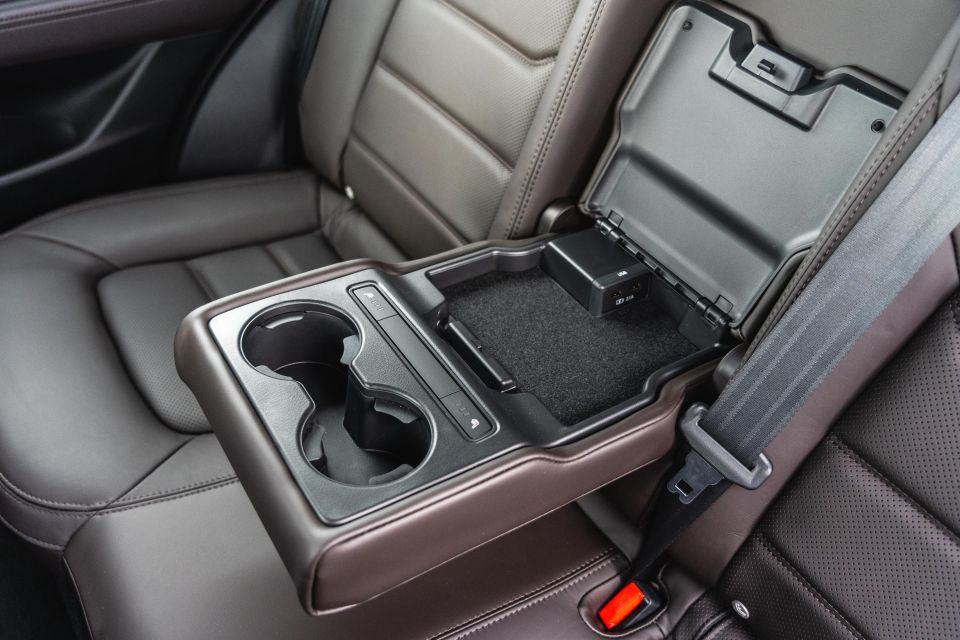
Stepping into the back, there’s noticeably less room in almost every dimension than the Haval. There’s also a more prominent driveline hump, making the centre-seat occupant less comfortable.
At 180cm, I can comfortably sit behind my own driver’s seat position without my knees being pressed against the seatbacks, so I wouldn’t call it cramped back here. Nevertheless, the Haval has a more palatial feel to its rear accommodations.
Like the Haval, you’ll find rear air vents plus bottle holders in the door, but the two USB-A outlets are located in the fold-down centre armrest, not at the base of the centre console. That’s a bit of a bother if you’re carrying three passengers in the rear.
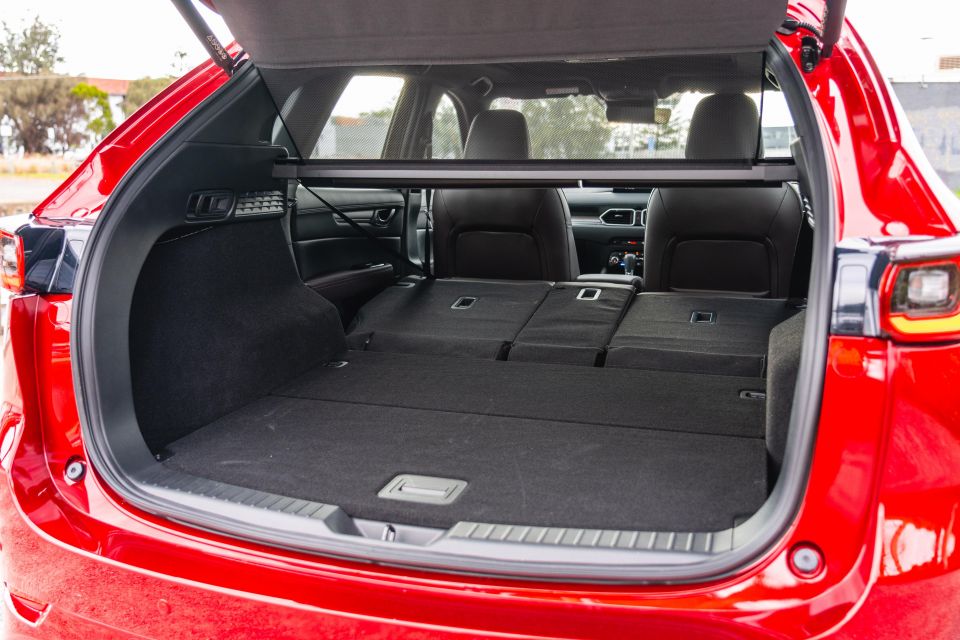
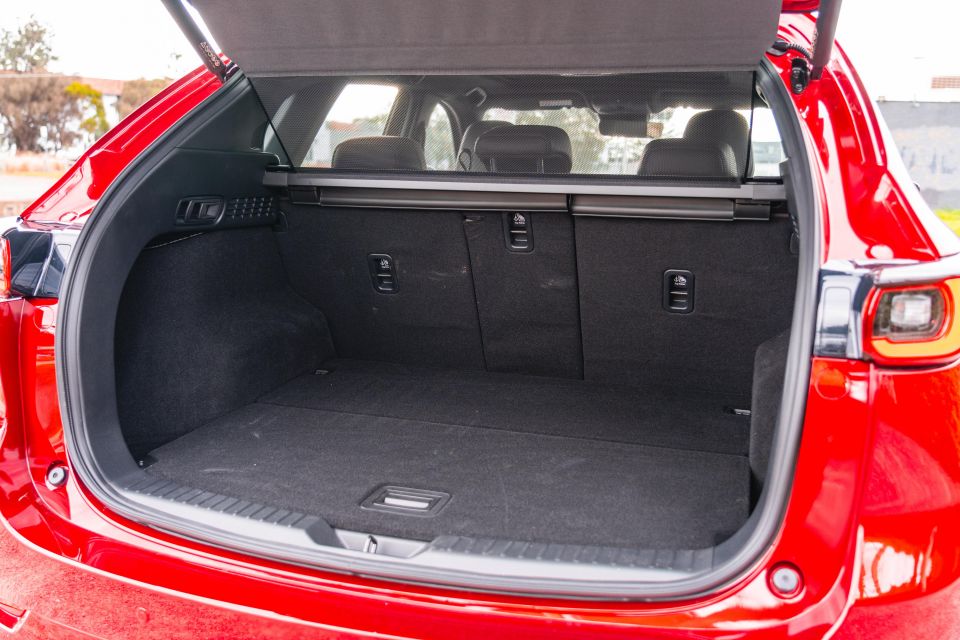
Where expert car reviews meet expert car buying – CarExpert gives you trusted advice, personalised service and real savings on your next new car.
Those rear seats split and fold 40:20:40, which is handy when carrying long items but multiple passengers.
The boot is also smaller than the Haval’s. Cargo space measures 442L up to the cargo cover, expanding to 1342L (measured to the roof) with the second row folded flat. Below the boot floor, you’ll find a space-saver spare.
Cleverly, the cargo cover opens with the tailgate.
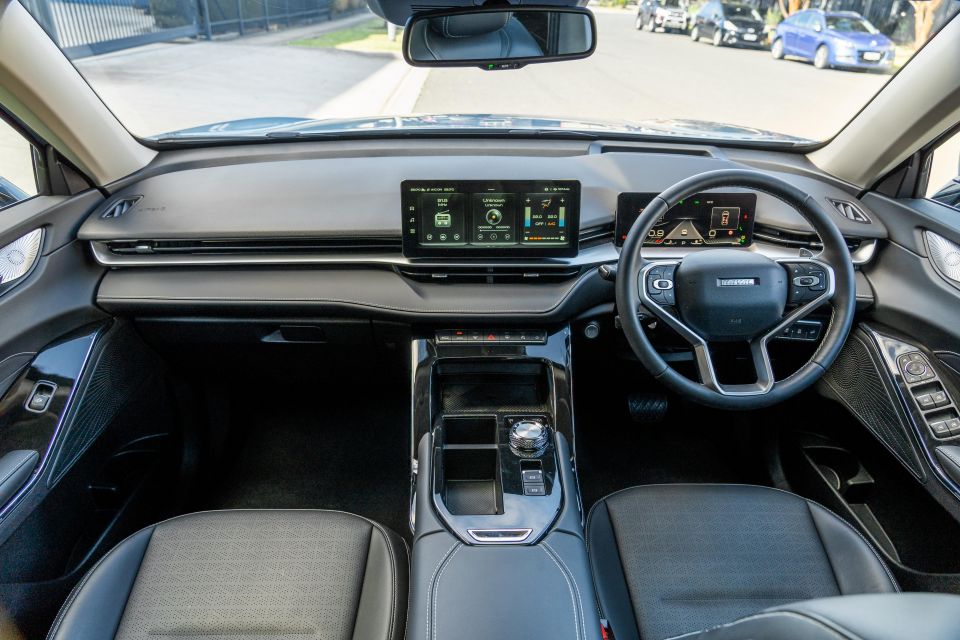
Haval H6
The Haval has a flashier interior design, although that doesn’t come at the expense of substance.
In terms of storage, for example, there’s still a large centre console bin plus bottle holders that’ll fit a 1L bottle. But the Haval also includes an enormous, rubberised shelf below the floating, bridge-like centre console, something the Mazda can’t match.
There are some peculiar useability issues. On either side of the centre console, for example, you’ll find a USB-A outlet, which seems handy until you realise it’s the passenger-side one you’ll have to plug your phone into to use smartphone mirroring. Come on, Haval.
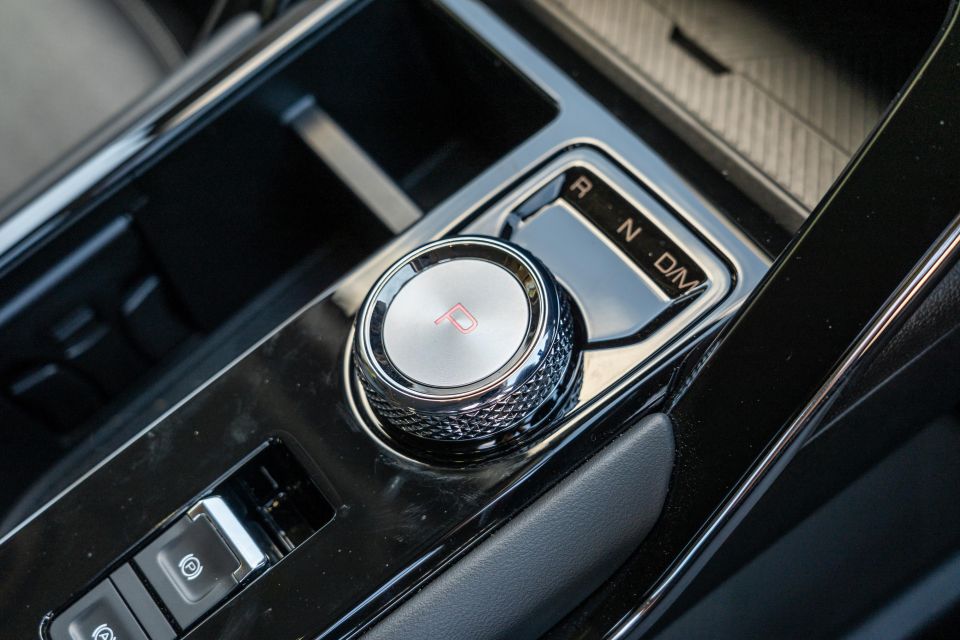
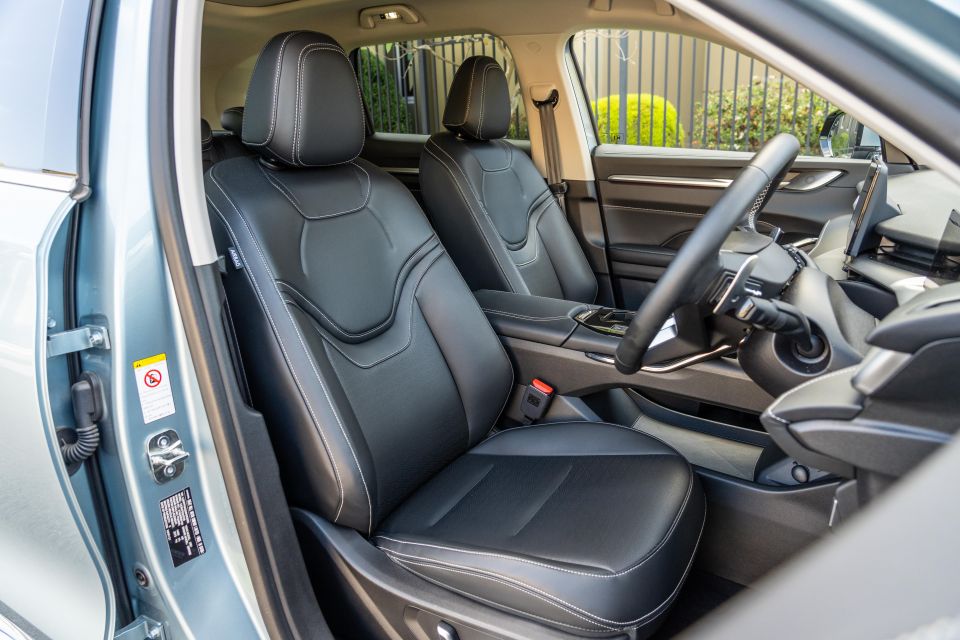
We would also prefer a more intuitive cruise control system, as the H6’s often concealed lever has a learning curve.
The tiered look to the dashboard is attractive and modern, though the free-standing instrument cluster looks a bit of an afterthought. We like the stitching details along the centre console bin lid and the dash, but there’s too much piano black trim on the centre console and the “metal-look” details on the doors are goofy.
Soft-touch materials are used on all but the lower reaches of the dashboard and front doors, while the rear doors are finished in hard plastic but still have leatherette inserts.

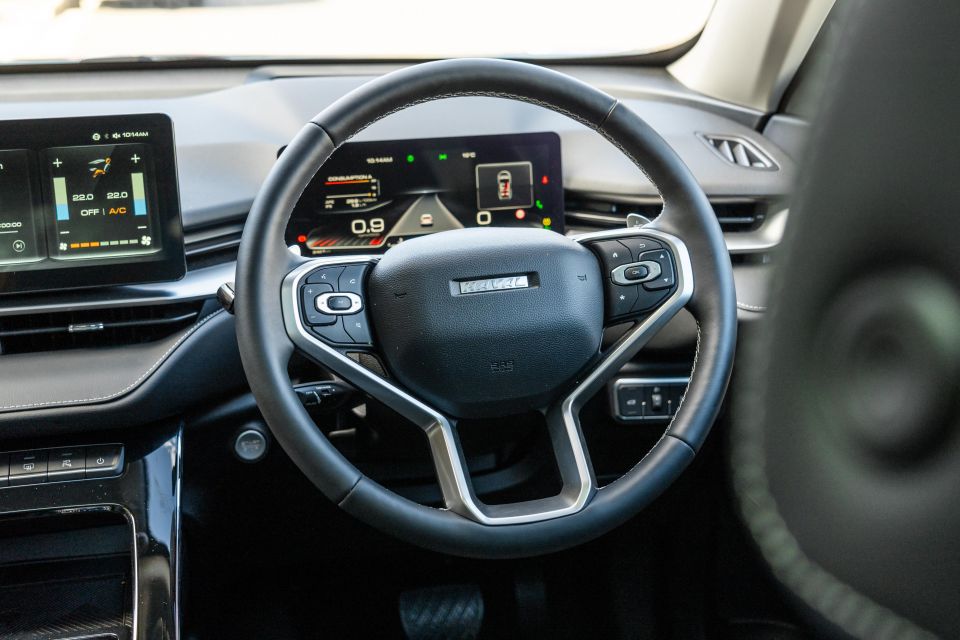
It doesn’t feel quite as plush inside as the Mazda, but the doors still close with a solid thunk and everything seems well-assembled. The one glaringly cheap element is the skinny steering wheel, with its thin rim and an exposed screw at the back.
While the Mazda has a rotary dial for the infotainment, the Haval instead has one for the transmission (a bit awkward when driving these back-to-back!) that features a nice knurled finish but can be twisted 360 degrees instead of between four set positions.
Like the Mazda, the Haval has a minimalist centre stack. Unfortunately, the Chinese brand has gone too far in the pursuit of minimalism, doing away with physical climate controls entirely.
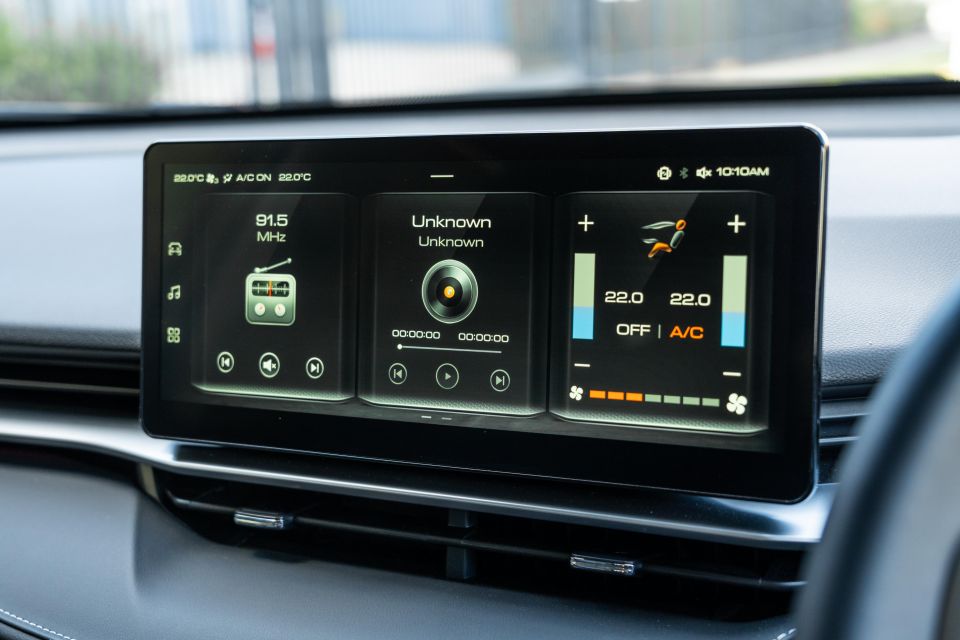
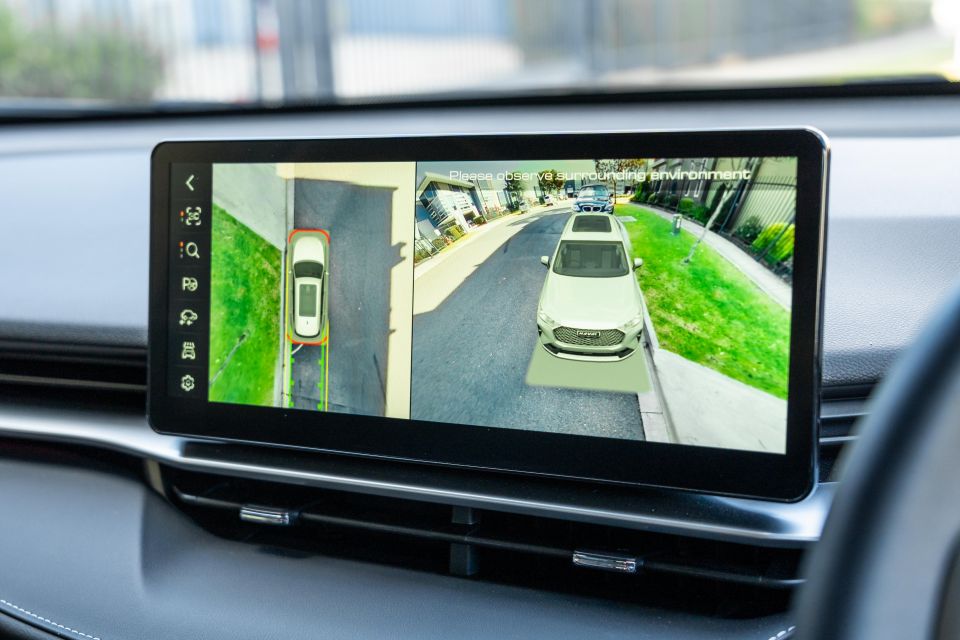
You can press a physical button to turn the air-conditioning on or off, but everything else is done via the touchscreen. That’s a pain when you’re using smartphone mirroring, as you have to exit the application to access the climate menu.
The touchscreen has a slick-looking interface but can be frustratingly laggy, and adjusting climate settings on the move is a particular pain point.
On a couple of occasions, I found I had unintentionally swiped the temperature bar too far and found myself in a 28-degree cabin on a warm day. It’s harder to end up in this situation with physical climate controls.
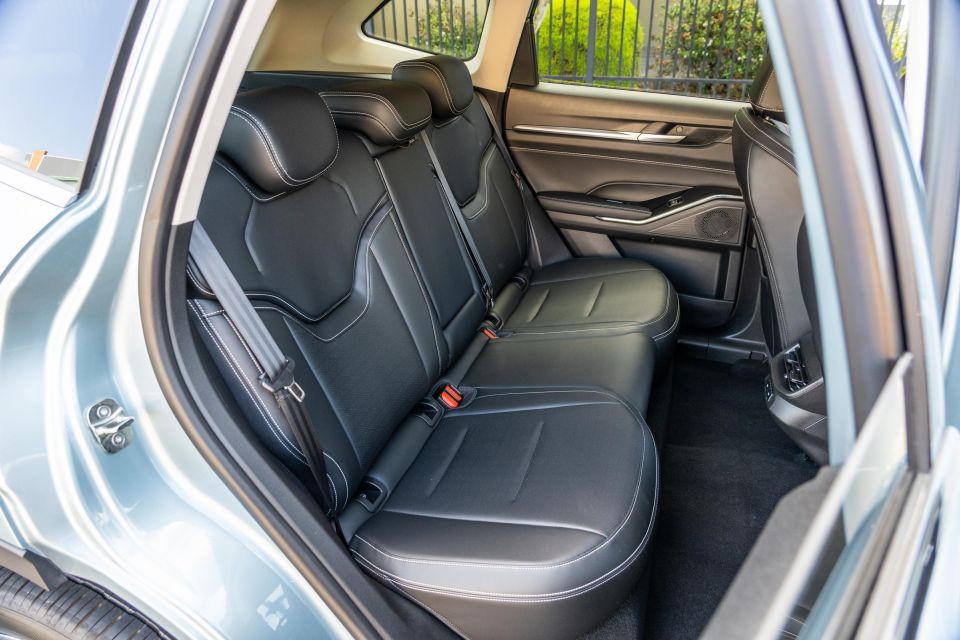
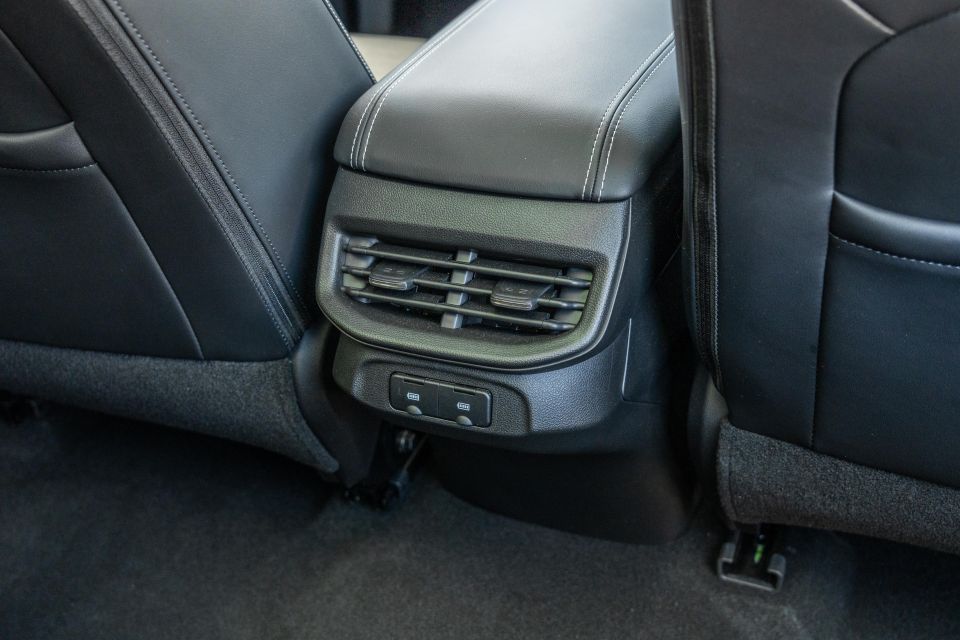
Functions like the heated and ventilated seats are also controlled solely via the touchscreen when the Mazda uses intuitive physical switches.
If you’re looking for satellite navigation, you won’t find it – you’ll need to use smartphone mirroring, although helpfully turn-by-turn navigation instructions can be displayed on the instrument cluster and head-up display.
The Mazda’s camera quality may be good for the class, but the Haval puts it and the rest of the segment in the shade. You can toggle between 2D and 3D views and swipe around the vehicle in BMW-like fashion, and the resolution is superb.
The seats up front are cushy, while rear-seat occupants are spoiled with plenty of room in every dimension. That includes headroom, despite the inclusion of a panoramic sunroof.
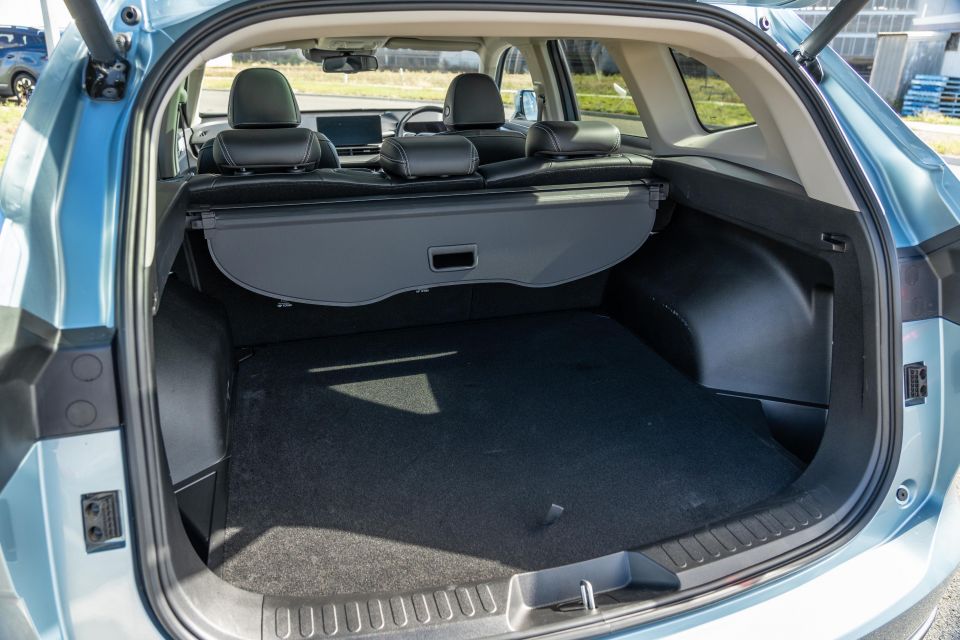
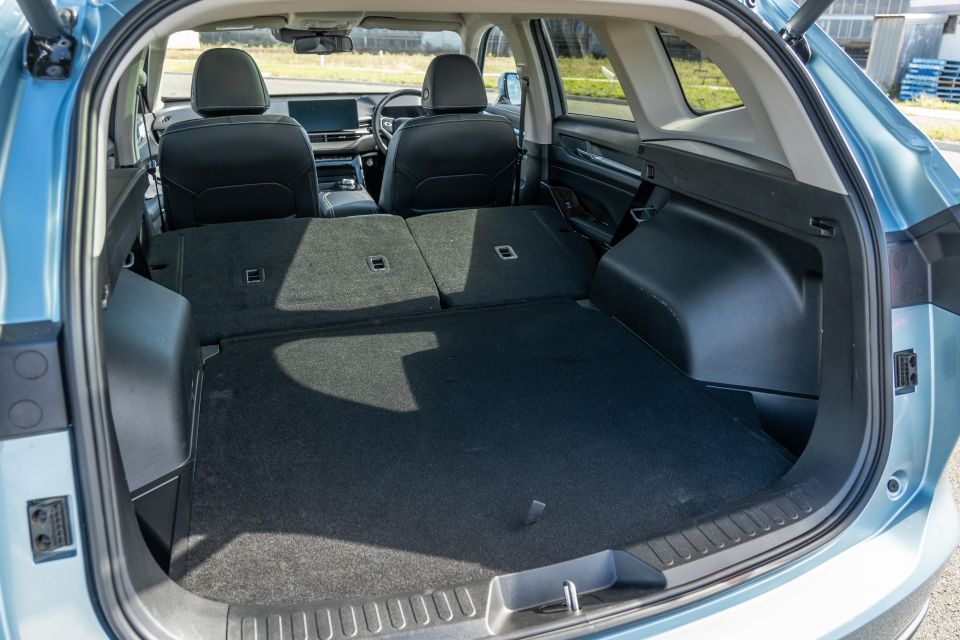
In terms of amenities, there are two USB-A outlets, a fold-down armrest with two cupholders, and rear air vents. Strangely, the rear doors don’t have a proper cutout for bottles and instead have a shelf of sorts for loose odds and ends to slide around in.
With the rear seats upright, the H6 has a boot capacity of 600L. This expands to 1485L with the rear seats folded down, though they only fold 60:40.
Under the boot floor you’ll find a space-saver spare, while on either side of the main boot floor you’ll find two open cubbies for storage. There’s also a 12V outlet.
| Mazda CX-5 Akera | Haval H6 Ultra | |
|---|---|---|
| Length | 4575mm | 4653mm |
| Width | 1845mm | 1886mm |
| Height | 1680mm | 1724mm |
| Wheelbase | 2700mm | 2738mm |
| Clearance | 200mm | 172mm |
| Boot | 438L | 600L |
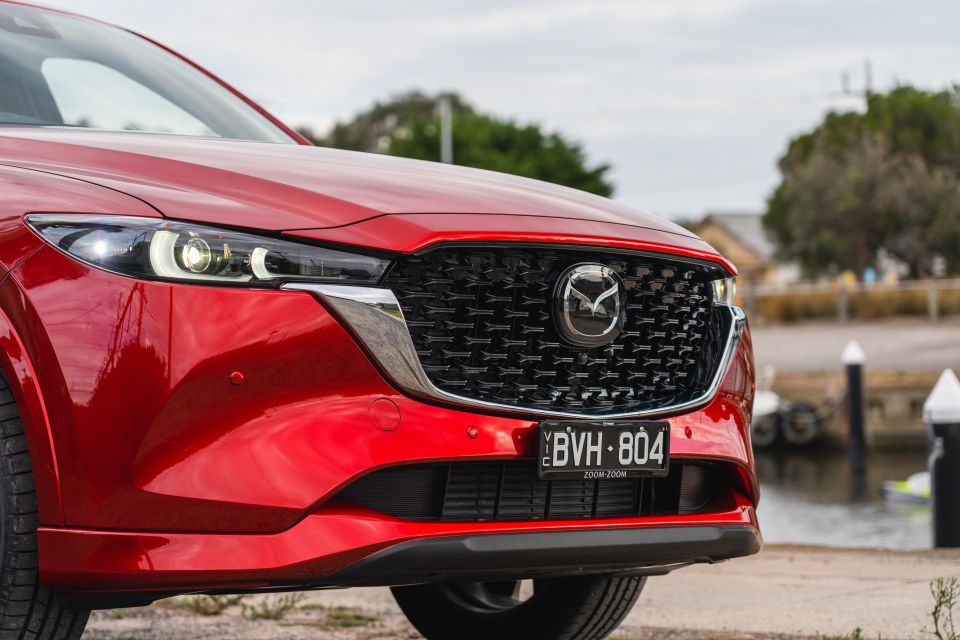
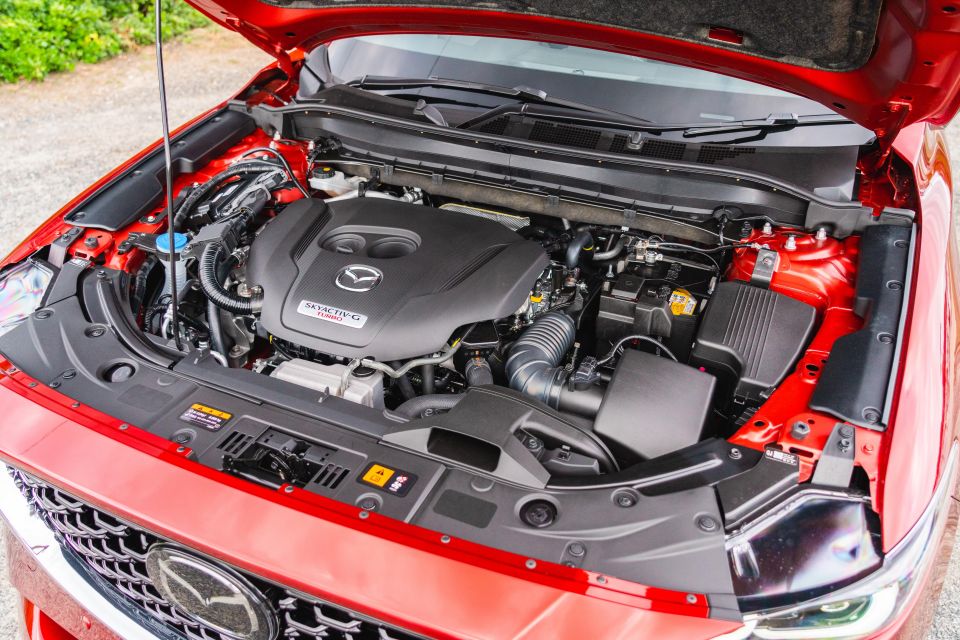
Mazda CX-5
While the Haval is offered with only two powertrains in Australia, the Mazda comes with a choice of four four-cylinder engines.
There are naturally-aspirated 2.0-litre and 2.5-litre petrols, a 2.2-litre twin-turbo diesel, and the featured turbocharged 2.5-litre petrol four-cylinder engine. All engines are available in top Akera spec bar the entry-level 2.0-litre.
The turbo-petrol pumps out 170kW of power at 5000rpm and 420Nm of torque at 2000rpm, making it one of the most powerful petrol engines in this segment. That torque figure, in particular, is impressive – it’s only 30Nm shy of the turbo-diesel.
All turbocharged CX-5s come exclusively with all-wheel drive and a six-speed automatic transmission.
Over a loop comprising inner-city, suburban and highway driving, albeit in fairly heavy traffic, we averaged 12.8L/100km. The combined cycle claim for the CX-5 is 8.2L/100km, but by the end of my time with the CX-5 it was averaging 10.5L/100km albeit with a heavy urban skew.
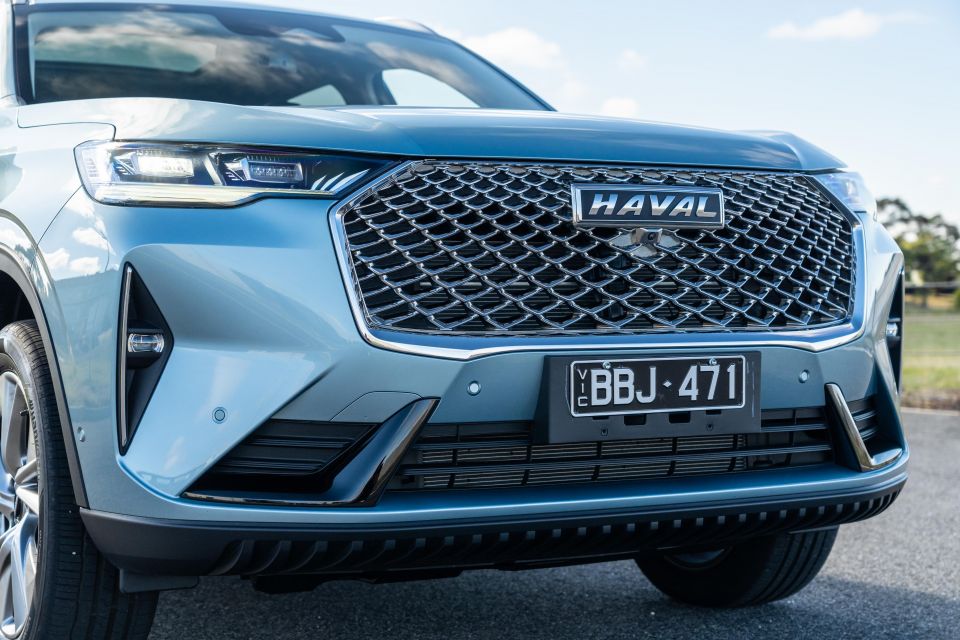
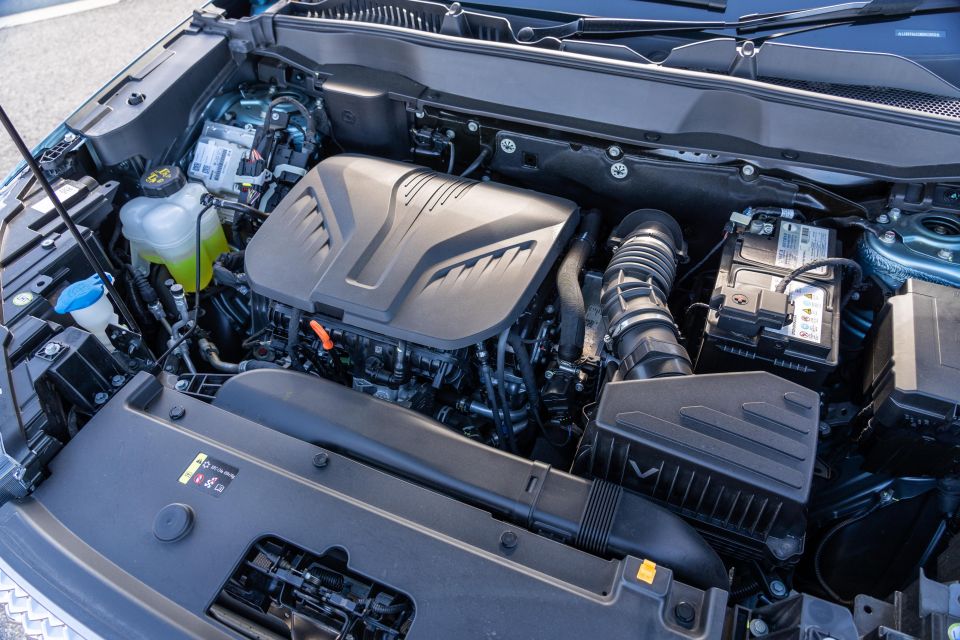
Haval H6
The H6’s engine outpunches the naturally-aspirated 2.0-litre and 2.5-litre CX-5s it’s priced up against, but it sits in the shadow of the more powerful (yet costlier) turbo 2.5-litre of our CX-5 tester.
Its turbocharged 2.0-litre four-cylinder engine produces 150kW of power at 6300rpm and 320Nm of torque between 1500 and 4000rpm, and is mated with a seven-speed dual-clutch automatic transmission.
The top-spec Ultra 2.0T is the only H6 available with all-wheel drive. Even the new hybrid model, which produces even more power and torque (179kW/530Nm), is available exclusively with front-wheel drive.
Over the same fuel economy loop as the Mazda, albeit with less traffic, we averaged 12.7L/100km. That’s against a claim of 8.3L/100km, something we couldn’t match. We averaged 8.5L/100km on a circa-400km round trip from Melbourne to Shepparton and back, spent almost entirely on highways.
| Mazda CX-5 Akera | Haval H6 Ultra | |
|---|---|---|
| Engine | 2.5-litre, 4-cyl, turbo | 2.0-litre, 4-cyl, turbo |
| Power | 170kW at 5000rpm | 150kW at 6300rpm |
| Torque | 420Nm at 2000rpm | 320Nm between 1500-4000rpm |
| Combined fuel economy – claimed | 8.2L/100km | 8.3L/100km |
| Combined fuel economy – observed | 12.8L/100km | 12.7L/100km |
| Fuel required | 91 RON regular unleaded | 91 RON regular unleaded |
| Fuel tank | 58L | 60L |
| Transmission | Six-speed torque-converter automatic | Seven-speed dual-clutch automatic |
| Drive type | All-wheel drive | All-wheel drive |
| Braked towing capacity | 2000kg | 2000kg |
| Weight | 1765kg (kerb) | 1625kg (tare) |
| Front suspension | MacPherson strut | MacPherson strut |
| Rear suspension | Trailing wishbone | Multi-link |
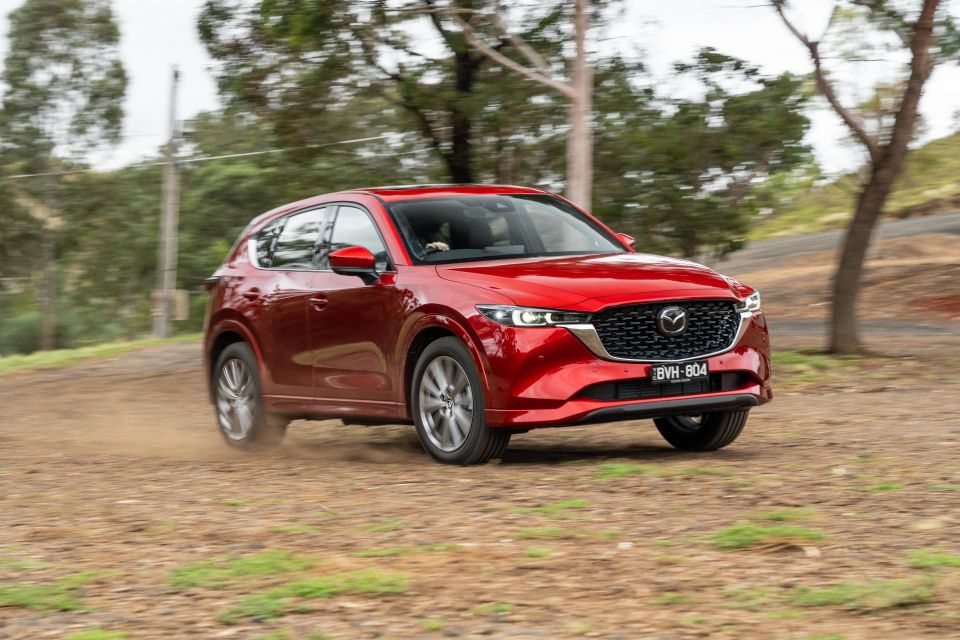
Mazda CX-5
Make no mistake, the Mazda CX-5 is still an impressive car to drive after all these years. Its engine really hits the sweet spot, and it’s the picture of refinement.
Mazdas may have once had a reputation for being a bit noisy, but the CX-5’s cabin is impressively hushed. Even if you plant your right foot, any engine noise entering the cabin is muted. The CX-5’s engine also has a sporty sound to it, and yet never sounds raucous.
Even at highway speeds, very little wind noise enters the cabin and there’s just a faint roar from the tyres.
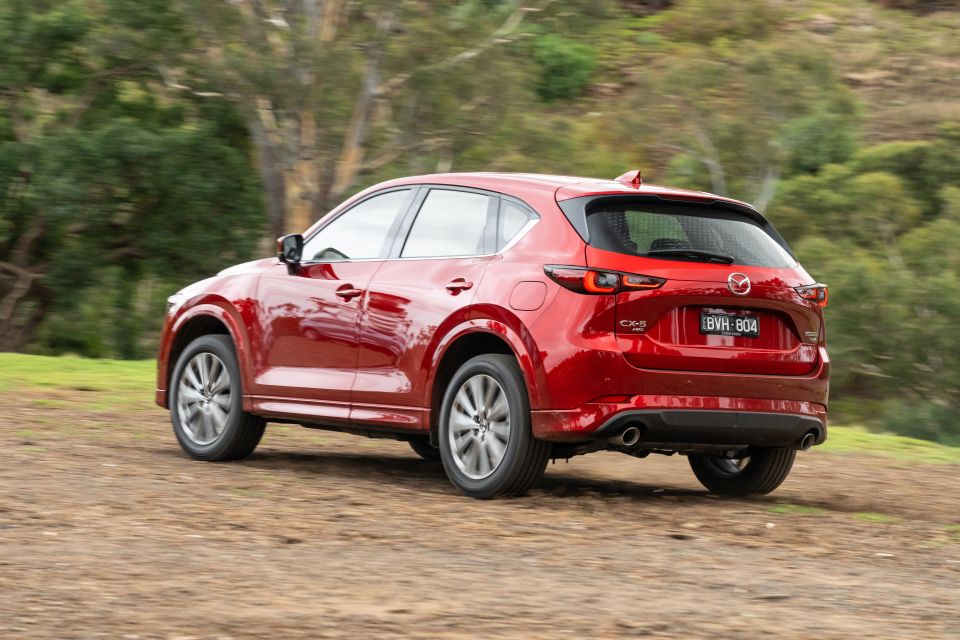
There’s a very linear feel to the torque-converter automatic, and while shifts mightn’t be as rapid as the H6, it doesn’t have the Haval’s delay off the line. Instead, there’s seemingly instant, effortless grunt. There’s really no need to activate Sport mode, and that mode holds gears a touch too long for my liking.
The CX-5 feels like a hot hatch against the H6, with a more hunkered-down feel. The steering is nicely-weighted – it’s comfortably light around town, but it has a nice heft to it when you pick up the pace.
It may feel sportier to drive than the Haval, but that doesn’t come at the expense of ride comfort. While it feels firmer overall, that also means it feels more tied down and planted on poorly-surfaced or undulating roads.
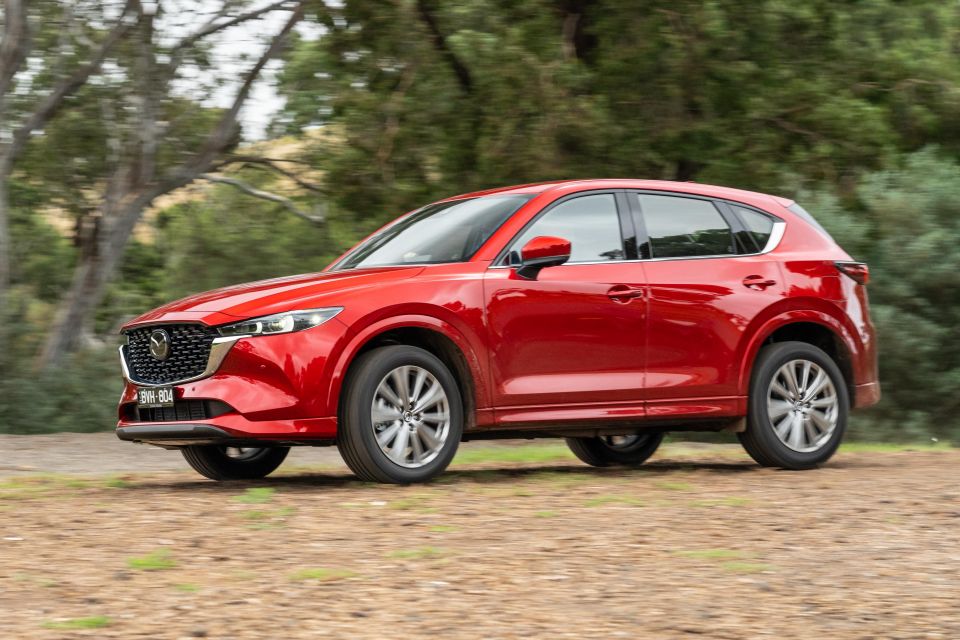
It’s quicker to settle over undulations, and absorbs larger ruts and corrugations better than the Haval.
Overall, the Mazda feels both sportier and more luxurious than the Haval. Our only quibble? The automatic stop/start can be a bit firm in its operation, though Mazda has at least programmed it to require a firm prod of the brake to activate.
The Mazda’s other systems work well, particularly its adaptive cruise control and lane-keep assist when operated in conjunction with each other.
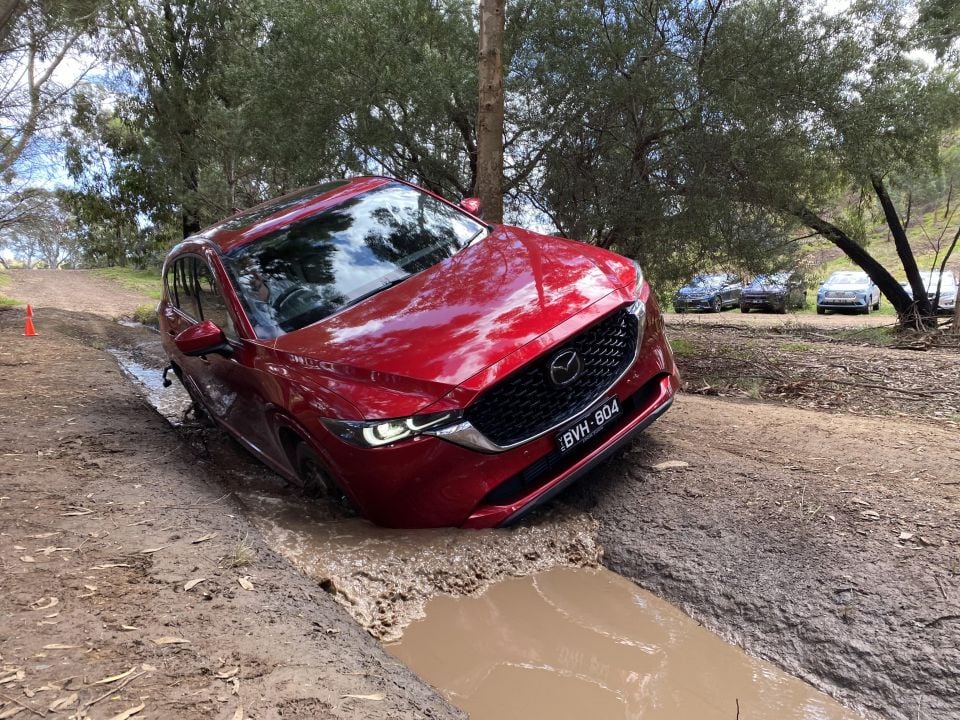
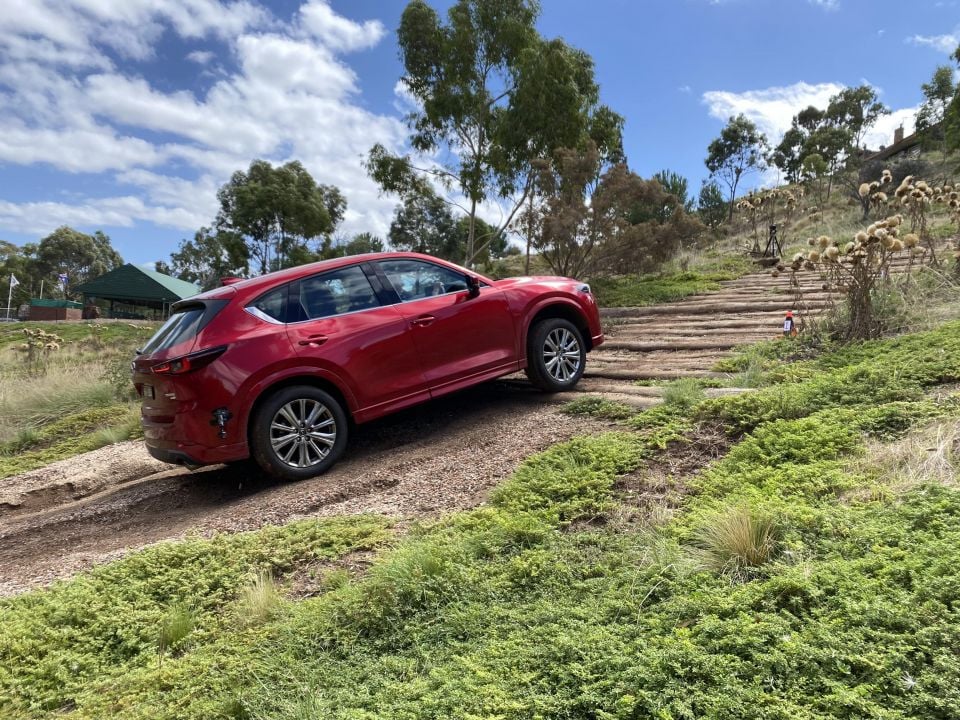
There’s a dedicated off-road drive mode, and the traction control system approximates a locking rear differential. That allowed us to easily clear a muddy, rutted trail and an offset mogul and, even with two diagonally opposed wheels sticking in the air, the CX-5’s all-wheel drive system managed to extricate the car when we applied steady, progressive throttle inputs.
We also experienced no issues with chassis flex, though the CX-5 couldn’t quite manage our “log mountain” test. Stopping the car halfway up a log hill and resuming the trek saw it spinning its front wheels and flashing a “high load” error message for the all-wheel drive system.
Tackling the same hill without stopping saw it clamber up with no issues.
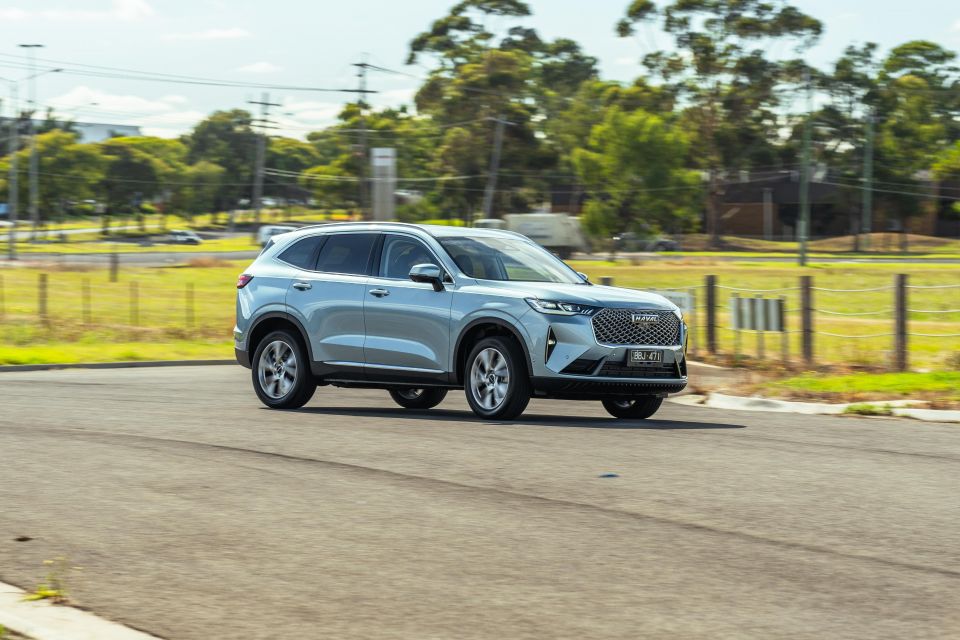
Haval H6
Against something like a Mitsubishi Outlander or Subaru Forester, the H6 would be a closer match. But the CX-5’s overall level of polish and refinement shades the H6, even if it doesn’t embarrass the Chinese SUV.
Perhaps the first thing you’ll notice driving the H6 after the CX-5 is the higher level of noise. The H6’s engine isn’t as muted as the CX-5’s, and has a strange, fluttering sound to it under heavier acceleration. There’s also more tyre roar that makes its way into the cabin.
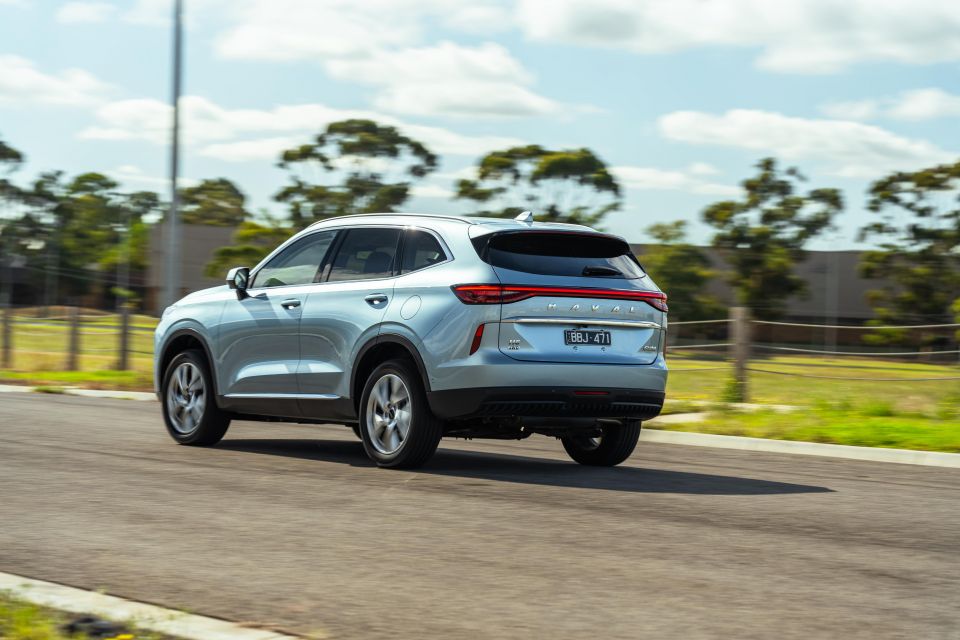
The steering is a bit numb in comparison to the Mazda, and therefore isn’t as confidence-inspiring. This isn’t a mid-sized SUV you’ll be seeking out the twisties in, but precious few in this segment are.
Shifts are rapid with the H6’s dual-clutch, though there’s a slight delay off the line. Creeping through heavy traffic also results in a rather jerky feeling from the transmission, frustrating when you’re stuck in peak hour traffic.
Body control and ride comfort isn’t as good as in the Mazda. Craggy roads the Mazda glides over can often be felt in the Haval, which gets jostled around a bit on poorly surfaced rural roads and feels ponderous over undulating roads.
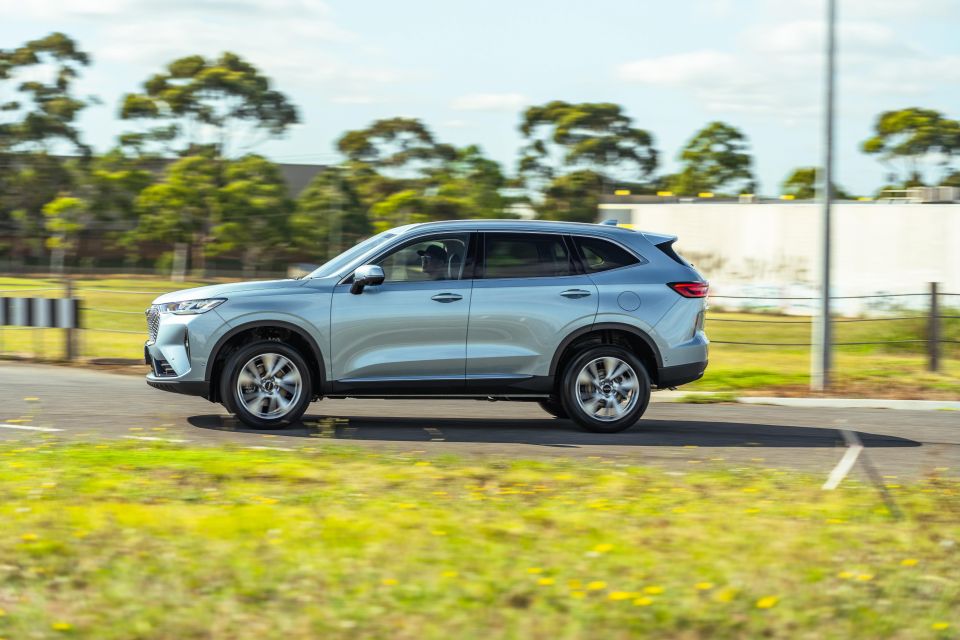
On truly horrendous corrugated roads, the H6 betrays a lack of damping compared to the CX-5.
Again, compared with something like an Outlander or an X-Trail the H6 would stack up better. Unfortunately, the CX-5 sets a terrific example for mid-sized SUVs and the H6 can’t quite measure up.
The H6 does a lot right, however. Over most surfaces, it furnishes a comfortable ride. Its engine is a bit noisy when revved, but there’s a good amount of grunt and the all-wheel drive system helps get this to the ground effectively. Its handling is benign and perfectly acceptable by the general standards of this segment.

There’s plenty of adjustability, too. You can choose between different drive modes, or even simply different modes for the steering – I generally left the steering in Sport and the drive mode in Normal.
The lane support systems can be toggled between a standard lane-departure warning, a lane-keep assist, or a setting with lane centring. Again, this is done via a sub-menu in the touchscreen.
Even with just lane-keep assist selected, the H6 can be a bit aggressive at keeping you within your lane, yanking the steering wheel at times. Nevertheless, the H6’s technology is very good at keeping you from veering into another lane and the lane centring makes highway driving almost mindless, though the adaptive cruise control would slow down the vehicle more than was necessary on highways with curves.
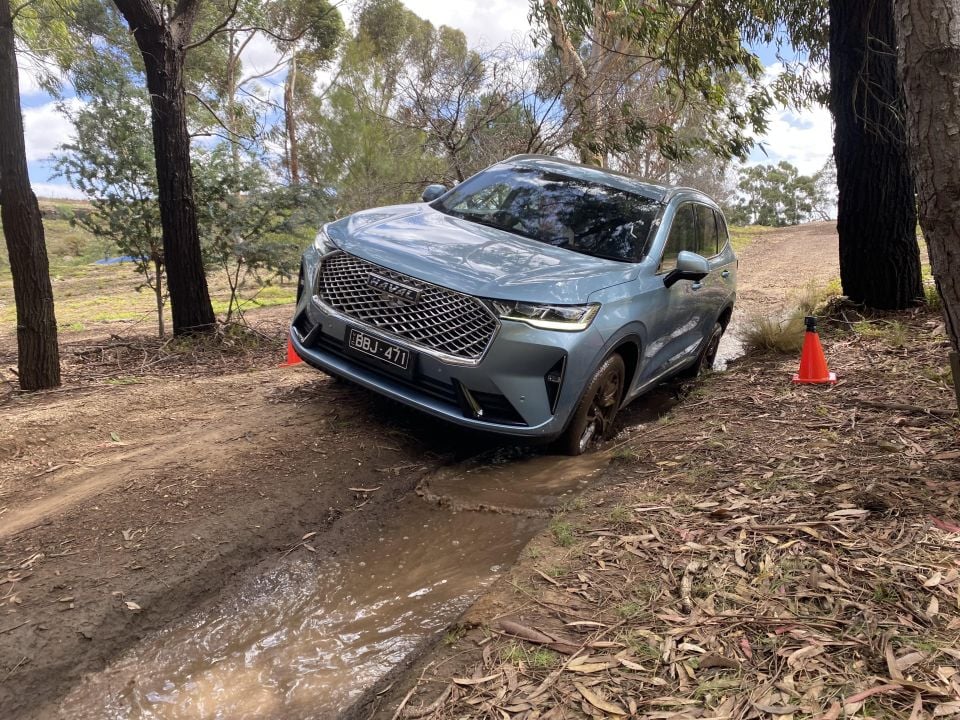
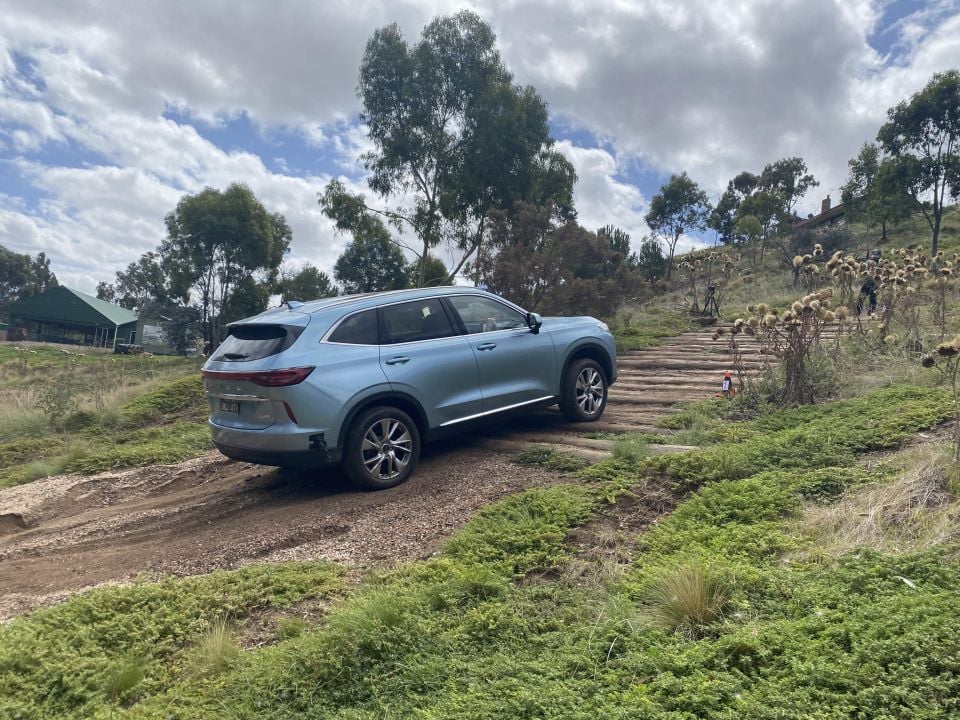
One aspect where the H6 trumped the CX-5 was on our uphill log climb at our off-road test site, and indeed the Haval was one of the pleasant surprises of our mid-sized SUV off-road comparison test.
We took both cars up a log-covered hill, stopping them halfway and then attempting to resume the ascent. The Haval had no problem recommencing the uphill trek, indicating well-tuned all-wheel drive and traction control systems.
The H6 boasts sand, snow and off-road drive modes. In spite of its limited ground clearance (170mm) and dual-clutch transmission, it cleared the muddy track and offset mogul. However, there were some loud clunks that appeared to be emanating from the transmission.
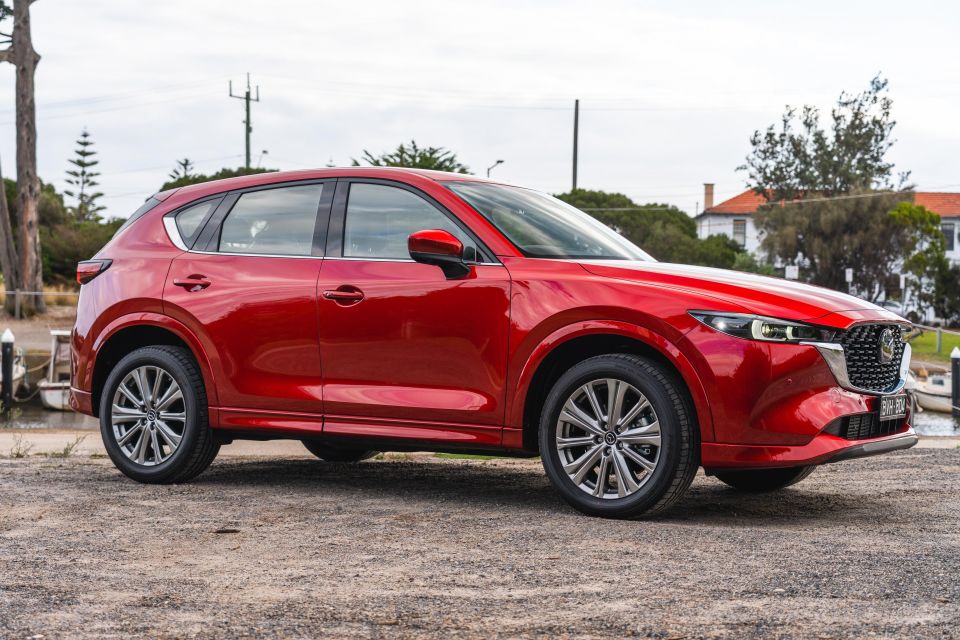
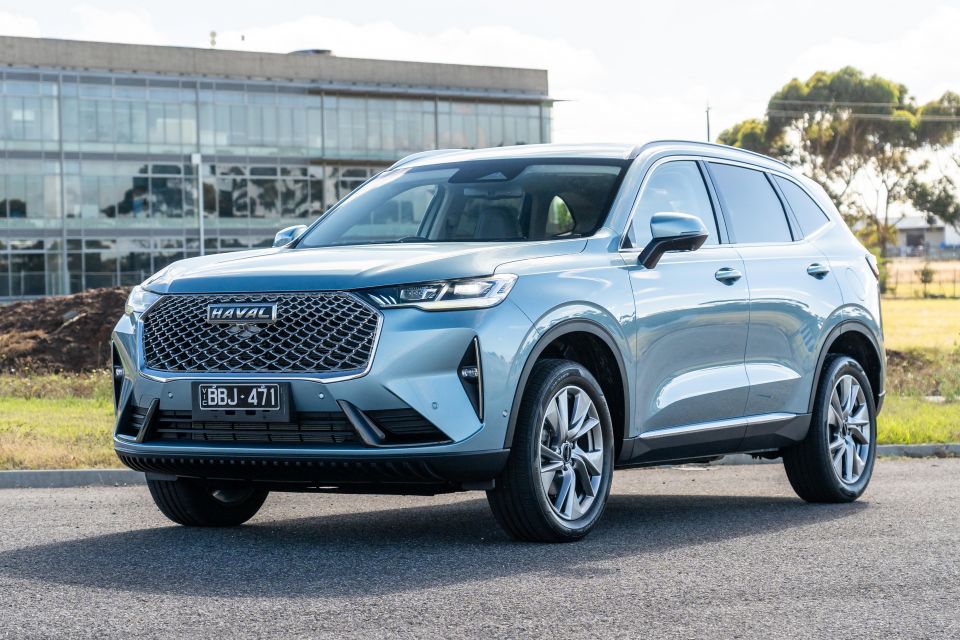
Mazda CX-5
The Mazda is covered by a five-year, unlimited-kilometre warranty and five years of roadside assist.
The company offers five years of capped-price servicing, with intervals of 12 months or 10,000km, whichever comes first.
The first five services are capped at $363, $393, $363, $393 and $363, or a total of $1875 over five years.
Haval H6
GWM Haval backs the H6 with a seven-year, unlimited-kilometre warranty with five years of roadside assist.
It offers capped-price servicing for the first five visits. The first is required at 12 months or 10,000km, while subsequent intervals are 12 months or 15,000km.
The first five services capped at $210, $280, $480, $580 and $210, or a total of $1760 over five years.
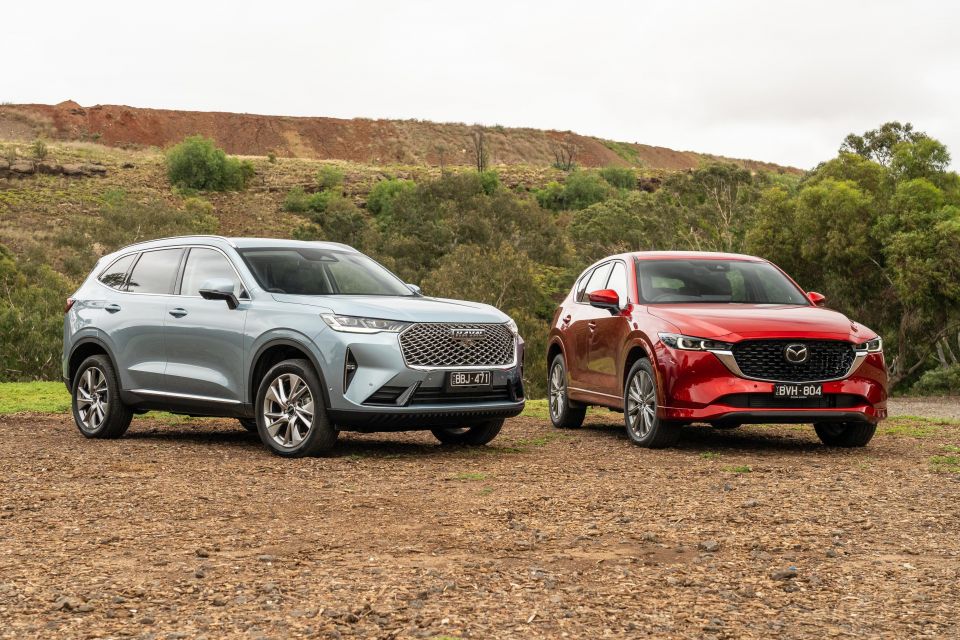
The Mazda CX-5 feels quieter, more refined and comfortable to drive, while also being quicker and sportier in feel. Its interior, including the technology, also feels better resolved. It feels closer to a luxury-brand SUV like a Lexus NX than arguably anything in its class.
But is the Haval H6 trounced in this match-up? No, not at all. It’s thousands of dollars cheaper, has a long warranty, a much more spacious cabin, and offers some features like semi-autonomous parking assist and a panoramic sunroof that you can’t get on any CX-5.
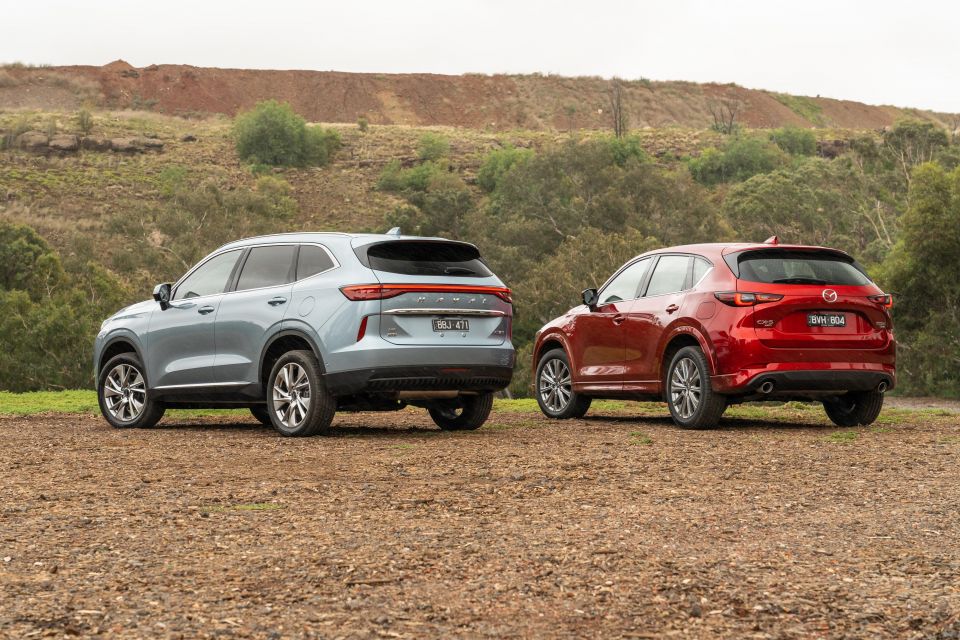
If you want a more engaging driving experience and a more upscale cabin, the CX-5 is arguably worth the premium. You also get the confidence of buying a vehicle from a more established brand, even if not every vehicle in the brand’s history has been a bastion of reliability (see: CX-7).
However, for the price of a H6 Ultra AWD you’re looking at a lower-spec CX-5 with a non-turbocharged engine. Put into that context, the H6 is a compelling bargain, even if its technology frustrates, it isn’t as refined, and it doesn’t have satellite navigation.
Is the CX-5 the better car overall? Yes, but you pay for that luxury.
MORE: Everything Haval H6 MORE: Everything Mazda CX-5
Share your thoughts with us in the comments below!
William Stopford is an automotive journalist with a passion for mainstream cars, automotive history and overseas auto markets.
Share your thoughts and write a review of a car you own and get featured on CarExpert.


Damion Smy
13 Hours Ago


Damion Smy
16 Hours Ago


Damion Smy
19 Hours Ago


Damion Smy
21 Hours Ago


Damion Smy
21 Hours Ago


Damion Smy
22 Hours Ago